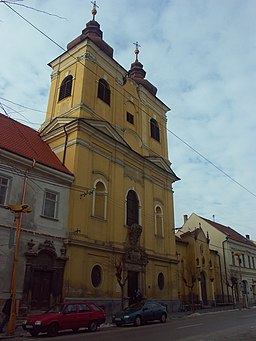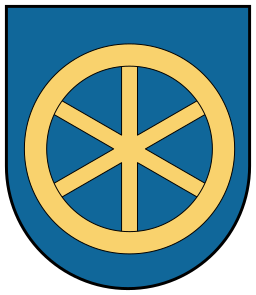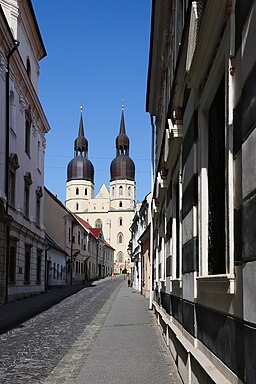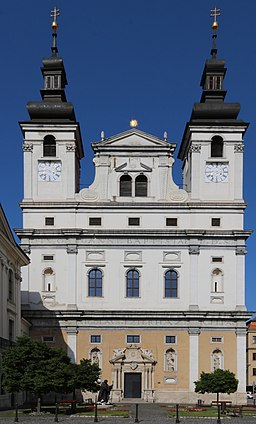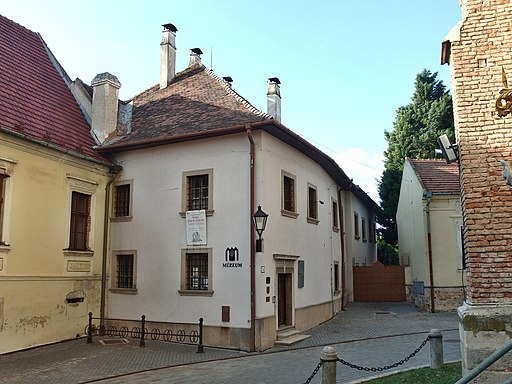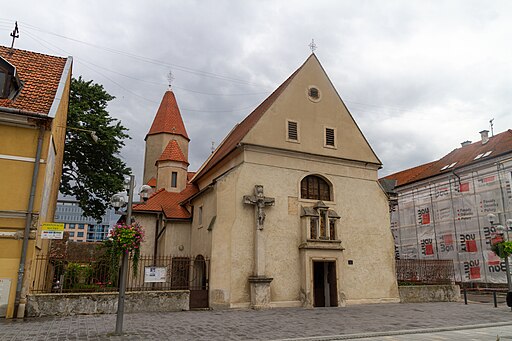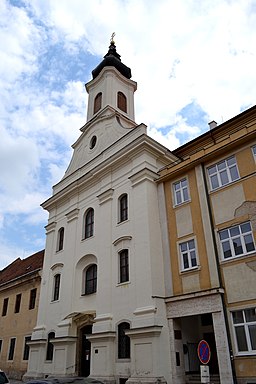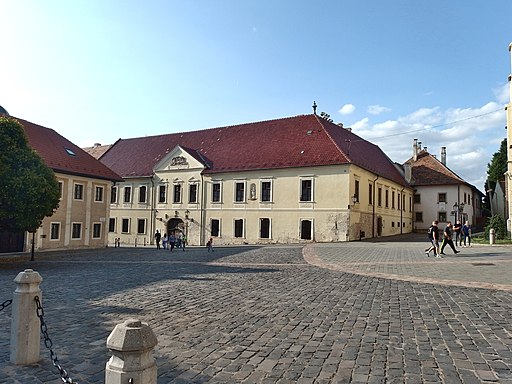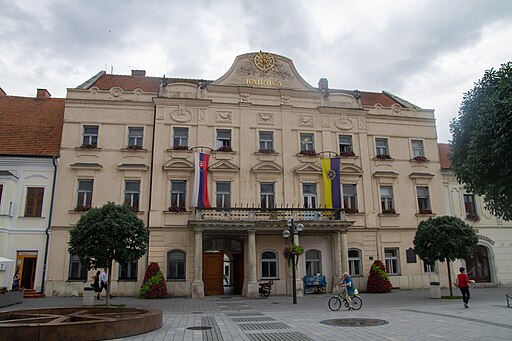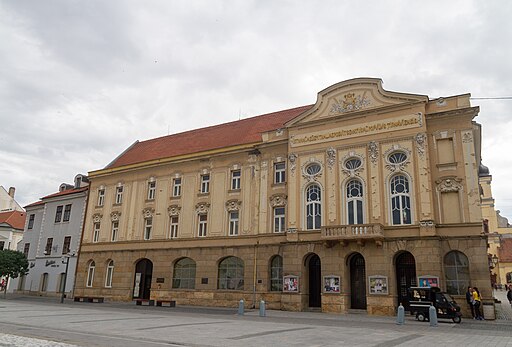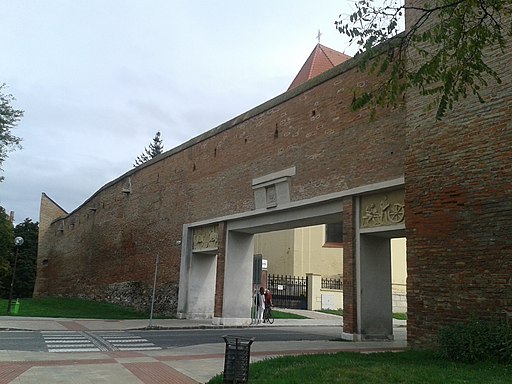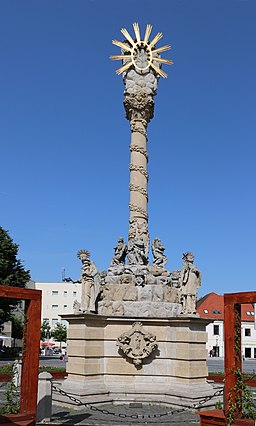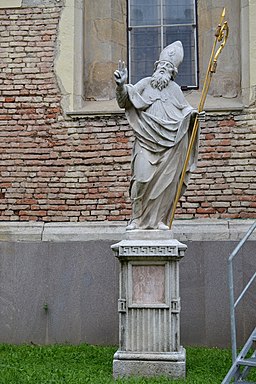Nagyszombat
Latin:
Tyrnavia, Tyrnaviae
Historical Hungarian county:
Pozsony
GPS coordinates:
48.377812, 17.586404
Population
Population in 1910
| Total |
15163 |
| Hungarian |
30.29% |
| German |
15.04% |
| Slovak |
52.97% |
The town located only 60 kilometers from Pozsony, to which it was once connected by the first horse-drawn railway of Hungary, is also called "little Rome" after its numerous churches and also because as the seat of the Archbishop of Esztergom it was the religious and cultural center of Hungary for nearly 300 years due to the Turkish conquest. Archbishop Pázmány Péter established a university here in 1635, which is still one of the most prestigious universities of Hungary seated now in Budapest. The town was an important trade hub and it got its name from its famous fairs held on Saturdays. It developed to one of the largest towns of Europe by the 13th century. It was one of the favorite places of King Louis the Great of Hungary to stay, he started the construction of the St. Nicholas Cathedral, and he also died here in 1382. The area is famous for its great wines and several cultural events await the visitors.
Check out other towns in Upper Hungary (Slovakia) as well!
895
Arrival of the Hungarians
Little more...
895
The alliance of the seven Hungarian tribes took possession of the then largely uninhabited Carpathian Basin. Until then, the sparse Slavic population of the north-western Carpathians had lived under Moravian rule for a few decades after the collapse of the Avar Khaganate in the early 9th century.
1000
Foundation of the Hungarian Kingdom
Little more...
1000
The Kingdom of Hungary was established with the coronation of King Stephen I. He converted the Hungarians to Christianity and created two archdioceses (Esztergom and Kalocsa) and ten dioceses. He divided Hungary into counties led by ispáns, who were appointed by the king.
1211
The settlement was mentioned by the name "Sumbot".
1241-1242
Mongol Invasion
Little more...
1241-1242
The hordes of the Mongol Empire invaded Hungary and almost completely destroyed it. One third to one half of the population was destroyed. The Mongols also suffered heavy losses in the battle of Muhi and they could not hunt down the king. After their withdrawal, King Béla IV reorganized Hungary. He allowed the feudal lords to build stone castles because they were able to successfully resist the nomadic Mongols. The vast majority of stone castles were built after this. The king called in German, Vlach (Romanian) and Slavic settlers to replace the destroyed population.
13th century
German migration, which increased after the Mongol invasion in 1241-42.
1238
King Béla IV of Hungary granted Nagyszombat the status of a free royal town. It was called Zumbotel (Szombathely, literally Saturday place).
April 1271
King Ottokar II of Bohemia occupied along with other castles and towns of northwest Hungary. He wanted to establish his own empire.
July 2, 1271
After the defeat of the army of Ottokar at Mosony, according to the peace treaty the occupied territories were regained by King Stephen V of Hungary.
August 8, 1273
Ottokar II of Bohemia invaded Hungary with a great army of 60 thousand Czech and German soldiers. Ottokar besieged and captured Pozsony and Nagyszombat. Afterwards he conquered many other towns and castles in the northwest of Hungary.
October 1273
The Hungarian army took back Nagyszombat, but Pozsony, Sopron, Mosony and Óvár with many other smaller castles remained in the hands of Ottokar.
November 21, 1276
The joint action of Rudolf I of Germany (also known as Rudolf of Habsburg) and László IV of Hungary (or Ladislaus the Cuman) forced Ottokar II of Bohemia to make peace. Hungary regained its territories and Ottokar made himself a vassal of Rudolf I of Germany.
July 12, 1277
King László IV of Hungary and Rudolf I strengthened their alliance. Ottokat II of Bohemia, who was reluctant to fulfill his obligations, finally gave back the occupied Hungarian castles.
1301
The extinction of the House of Árpád
Little more...
1301
The House of Árpád, the first Hungarian royal dynasty, died out with the death of King Andrew III. Hungary was ruled by oligarchs, the most powerful of whom was Csák Máté, whose main ally was the Aba family. King Charles I (1308-1342), supported by the Pope, eventually emerged as the most prominent of the contenders for the Hungarian throne. But it took decades to break the power of the oligarchs.
February 1327
King Charles I of Hungary made an alliance with King John of Bohemia in Nagyszombat in order to support Duke Otto of Austria against the other Austrian dukes. They also agreed to mint gold and silver coins.
February 1328
Charles I of Hungary launched his campaign against Austria and occupied several castles. On the 23th of July John of Bohemia also attacked.
September 21, 1328
A peace was negotiated in Bruck an der Leitha. Hungary recovered Pozsony, which had been under Austrian administration since 1301.
1360
King Louis I of Hungary (Louis the Great) and Charles IV Holy Roman Emperor made a friendship agreement in Nagyszombat.
September 10, 1382
King Louis I of Hungary (also known as Louis the Great) died in Nagyszombat, which was one of his favorite place of residence.
spring 1430
A Czech Hussite army, the so called Orphans of Žižka, under the command of Velek broke into the valley of Vág. After having plundered the whole valley, they set up camp next to Nagyszombat. King Sigismund of Hungary sent out Stiboricz, son of Stibor and Mathis János against them. Mathis arrived late to the battle, so the victory demanded heavy casualties. The Hussite commander, Velek perished and the Hussites left Hungary.
September 27, 1431
The Hussites broke into Hungary again and occupied Likava castle. Prokóp's army advanced southwards along the river Vág and plundered around Nagyszombat, Nyitra and Galgóc, while the Orphans of Žižka made their way to Léva and threatened the mining towns. The queen, Cillei Borbála sent Rozgonyi Miklós and Berzeviczi Pohárnok István against them. The army of Prokóp retreated to the Moravian border before Rozgonyi, so the Hungarian army could concentrate on the Orphans.
November 9, 1431
The battle was fought around Illava. 5 out of 7 thousand of the Orphans of Žižka lay dead and much of their war wagons and cannons fell to Hungarian hands.
1432
The Czech Hussite marauders attacked Hungary again and occupied Nagyszombat. The Hussites entered the town by disguising themselves as merchants, and they cut down the guards by night. The town became the staring point for their plundering raids. The town got Slavicised because of the Hussite rascals. The Hussites occupied Szakolca and Körmöcbánya and they even besieged Pozsony. Rozgonyi István and György saved Pozsony, but they could not retake Nagyszombat. The Hussites put strong garrison in the occupied castles.
1434
The army of Lévai Cseh Péter and Wallenrad János took back Nagyszombat from the Hussite thugs.
1440
After the death of King Albert of the House of Habsburg, the Estates of Hungary elected the Polish Ulászló to the throne. Elisabeth, the widow queen, in order to secure the throne for László, her baby boy, called in the Czech Hussite mercenary leader Jan Jiskra. She gave him the title "Captain of the Mining Towns and Kassa", and gave him the castle of Zólyom.
1440-1441
The Czech Hussites soon occupied much of northern Hungary. They reinforced the castles and turned them into bandit lairs. They were pillaging everywhere and large areas became uninhabited. They wiped out the local German and Hungarian population, who were replaced by Czech and other Slavic settlers. The Czech Hussite devastation largely contributed to the Slavicisation of northern Hungary (now Slovakia).
1462
At the end of the war that King Matthias of Hungary had waged against the Hussites since 1458, Jiskra swore loyalty to the king and handed over the castles he still held. Afterwards Jiskra fought in the service of King Matthias until his death.
1526
Battle of Mohács and the splitting of Hungary into two parts
Little more...
1526
Sultan Suleiman I launched a war against Vienna, instigated by the French. Ferdinand I, Duke of Austria, was the brother-in-law of King Louis II of Hungary. The army of the Ottoman Empire defeated the much smaller Hungarian army at Mohács, and King Louis II died in the battle. A group of the barons elected Ferdinand I of the House of Habsburg to the throne, who promised to defend Hungary from the Turks. He was the younger brother of the most powerful European monarch Emperor Charles V. But the nobility chose the most powerful Hungarian baron, Szapolyai János, who was also crowned as King John I. The country was split in two and a decades-long struggle for power began.
1541
The Turkish occupation of the capital, Buda, and the division of Hungary into three parts
Little more...
1541
The Turks conquered Buda, the capital of Hungary, after the death of King John I. The central part of the country was under Turkish rule for 150 years. The western and northern parts (including present-day Slovakia) formed the Kingdom of Hungary ruled by the Habsburg emperors. The eastern parts (now mainly under Romanian rule) were ruled by the successors of King John I of Hungary, who later established the Principality of Transylvania.
1543-1822
After Esztergom fell to the Ottomans, Nagyszombat became the seat of the Archbishop of Esztergom, the head of the Hungarian Roman Catholic Church.
1561
Jesuits were invited to the town. They opened schools.
1570
The establishment of the Principality of Transylvania
Little more...
1570
John II (John Sigismund), the son of King John I of Hungary, renounced the title of King of Hungary in favor of King Maximilian of the House of Habsburg, and henceforth held the title of Prince. This formally created the Principality of Transylvania, which was the eastern half of Hungary not ruled by the Habsburgs and was also a vassal of the Ottoman Empire. John II died in 1571, after which the three nations of Transylvania (the Hungarian nobility, the Székelys and the Saxons) elected the prince.
1573
Káldi György, the first Hungarian Catholic Bible translator was born in the town.
1577
A printing press was founded.
1604-1606
Uprising of Bocskai István
Little more...
1604-1606
The alliance of the Habsburgs and the Principality of Transylvania was defeated by the Ottoman Empire in the Fifteen Years' War. The war devastated Transylvania, which was occupied by the Habsburg imperial army, and General Basta introduced a reign of terror. The nobility and the burghers were upset about the terror, the plundering mercenaries and the violent Counter-Reformation. Bocskai István decided to lead their uprising after the Habsburg emperor tried to confiscate his estates. Bocskai also rallied the hajdú warriors to his side. He was elected Prince of Transylvania and soon liberated the Kingdom of Hungary from the Habsburgs. In 1605 Bocskai István was crowned King of Hungary with the crown he received from the Turks.
May 3-5, 1605
The hajdú fighters of Rhédey Ferenc occupied the town for Bocskai István.
23 June 1606
Peace of Vienna
Little more...
23 June 1606
Bocski István made peace with Emperor Rudolf. Their agreement secured the constitutional rights of the Estates of Hungary, and the freedom of religion. The counties of Szatmár, Bereg and Ugocsa were annexed to the Principality of Transylvania. Bocskai died of illness in the same year, leaving to his successors the idea of unifying Hungary from Transylvania.
May 6, 1615
In the first agreement of Nagyszombat Emperor Matthias II accepted Bethlen Gábor as Prince of Transylvania, resigned from the town of Nagyvárad in his favor and gave him back the castles of Huszt, Kővár and Tasnád together with Máramaros County.
July 31, 1617
The second agreement of Nagyszombar reaffirmed the first agreement.
1619
The campaign of Prince Bethlen Gábor of Transylvania in the Thirty Years' War
Little more...
1619
At the beginning of the Thirty Years' War (1618-1648), Prince Bethlen Gábor of Transylvania went to war against the Habsburg emperor as an ally of the rebelling Czech-Moravian-Austrian estates. The whole Kingdom of Hungary joined him, only the Austrian defenders of Pozsony had to be put to the sword. With his allies, he laid siege to Vienna. However, he was forced to abandon the siege because the Habsburg-loyal Hungarian aristocrat Homonnai Drugeth György attacked his heartland with Polish mercenaries. On 25 August 1620, the Diet of Besztercebánya elected Bethlen Gábor King of Hungary as vassal of the Turks. He continued to fight after the defeat of the Czechs at White Mountain on 8 November 1620, but without real chance to achieve decisive victory, he decided to come to an agreement with Emperor Ferdinand II.
October 9, 1619
Prince Bethlen Gábor of Transylvania marched into Nagyszombat without any resistance. He negotiated with the emissaries of the Czech insurgents and sent 12 thousand horsemen to their aid under the command of Rhédey Ferenc.
April 30, 1621
The Imperial army marched into Nagyszombat, but the castle surrendered only on the 6th of May after a siege.
July 25, 1621
The Transylvanian army of Bornemissza János defeated the Imperial army of Pálffy István.
July 30, 1621
The town opened gates before the Transylvanian army of Bornemissza János after two days of gunfire.
August 9, 1621
Marquis János György of Jägerndorf with his army of 8 thousand joined Prince Bethlen Gábor of Transylvania in Nagyszombat and together they set out to besiege Pozsony.
31 December 1621
Peace of Nikolsburg
Little more...
31 December 1621
Prince Bethlen Gábor of Transylvania made peace with Emperor Ferdinand II. Their agreement secured the constitutional rights of the Estates of Hungary, and later it was supplemented with the freedom of religion. Bethlen renounced the title of King of Hungary in exchange for seven counties of the Upper Tisza region (Szabolcs, Szatmár, Bereg, Ugocsa, Zemplén, Borsod, Abaúj) for the rest of his life, other estates in Hungary as his private property and the imperial title of Duke of Oppeln and Ratibor (Opole and Racibórz), one of the Duchies of Silesia. Prince Bethlen went to war against the Habsburgs in 1623 and 1626, but was unable to negotiate more favourable terms.
after October 10, 1623
The army of Prince Bethlen Gábor of Transylvania forced the Imperial army sent to defend Nagyszombat to surrender at Bogdanóc.
October 13, 1623
Prince Bethlen Gábor entered Nagyszombat and called for a country assembly.
October 15, 1623
The Turkish army of Serdar Ibrahim arrived in Nagyszombat. Afterwards Prince Bethlen Gábor and the Turks marched against Moravia.
May 6, 1635
Pázmány Péter, Archbishop of Esztergom founded a university in Nagyszombat. It became the center of Hungarian culture. He made his works and speeches translated to Slovak as well, thus he laid the foundations of the Slovak literacy.
1644-1645
The campaign of Prince Rákóczi György I of Transylvania in the Thirty Years' War
Little more...
1644-1645
Prince Rákóczi György I of Transylvania allied with the Swedes and the French in the Thirty Years' War and went to war against the Habsburg Emperor Ferdinand III. On 18 July 1645 his army joined forces with Torstenson's Swedish army under Brno (Moravia). The excellent artillery of Transylvania opened fire on the city walls. However, Rákóczi had to give up the siege, having been informed that the Turks were planning a punitive campaign against Transylvania, because he went to war against the Sultan's prohibition.
July 1645
Prince Rákóczi György I of Transylvania occupied Nagyszombat. Afterwards he joined the Swedish army of Torstenson under Brno on the 18th of July 1645. The excellent Transylvanian artillery started to fire at the walls of the town. But Rákóczi, fearing the retaliation of the Ottomans, who forbade him to fight against the Habsburgs, finally withdrew his forces.
16 December 1645
Peace of Linz
Little more...
16 December 1645
Prince Rákóczi György I of Transylvania made peace with Emperor Ferdinand III. It secured the freedom of religion for the Protestants and extended it also to the serfs. Rákóczi received the same seven Hungarian counties that Prince Bethlen Gábor had also held (Abauj, Zemplén, Borsod, Bereg, Ugocsa, Szabolcs, Szatmár) until his death, and the counties of Szabolcs and Szatmár were also to be inherited by his sons. The Rákóczi family also received several new estates.
after 1671
Kuruc Movement
Little more...
after 1671
Many noble, burgher and preacher fled to the Principality of Transylvania and the territory under Turkish occupation from the reprisals after the exposure of the anti-Habsburg Wesselényi-conspiracy and from the violent Counter-Reformation. They were joined by dismissed Hungarian soldiers of the Turkish border forts, who were replaced by German mercenaries. They were called the fugitives (bujdosók). They started an armed movement against the Habsburg rule. Because of the Turkish ban, the Principality of Transylvania could not openly support them. From 1677, the French supported their cause with money and Polish mercenaries. They achieved their first serious success when they temporarily occupied the mining towns of northern Hungary (now central Slovakia) under the command of Thököly lmre. He then became the sole leader of the movement. In 1679, the French made peace with Emperor Leopold I and withdrew their support for the fugitives. Between 1678 and 1681 Thököly Imre led successful raids against the Habsburgs and their supporters in the territory of the Kingdom of Hungary. The insurgents were called kurucs.
1682
Thököly Imre, Prince of Upper Hungary
Little more...
1682
Thököly Imre, the leader of the kuruc insurgents, gained the support of the Turks. He launched a campaign against the Habsburgs in the Kingdom of Hungary. With the support of the Turkish army, he occupied the town of Kassa and also the important stronghold of Fülek. He was then recognized by the Turks as King of Hungary, but he chose the title of Prince of Upper Hungary.
July, 1683
Nagyszombat surrendered to the kuruc army of Thököly Imre. The Imperial forces retreated to Vienna because a large Ottoman army was on the way to besiege the Imperial capital.
August 7, 1683
After Charles V, Duke of Lorraine drove him out of Pozsony, Thököly Imre retreated to Nagyszombat. The kuruc soldiers set a barn on fire. The fire spread to the town. The citizens, afraid of the lootings, did not dare to open the gates. 4 thousand people died in the town because of the fire and the smoke and the whole town burned down.
1683
Turkish defeat at Vienna and the formation of the Holy League
Little more...
1683
The combined armies of the Habsburg Empire and the Kingdom of Poland defeated the Turkish army besieging Vienna. Emperor Leopold I wanted to make peace with the Turks, but was refused by Sultan Mehmed IV. In 1684, at the persistent urging of Pope Innocent XI, the Holy League, an alliance of the Kingdom of Poland, the Habsburg Empire, the Republic of Venice and the Papal States, was formed to expel the Turks from Hungary. Thököly Imre, who had allied himself with the Turks, was gradually driven out of northern Hungary.
September 12, 1683
In the battle of Kahlenberg John III Sobieski of Poland and Charles V, Duke of Lorraine defeated the army of Grand Vizier Kara Musztafa that besieged Vienna. Thököly Imre retreated towards the east.
1685
The Turkish captivity of Thököly Imre and the fall of the kuruc movement
Little more...
1685
The Pasha of Várad captured Thököly Imre as he was asking for Turkish help and offered him to Emperor Leopold I for peace. But the Imperial emissaries laughed at his face, because, having the upper hand, they no longer cared for Thököly. On the news of his capture, the town of Kassa and the kuruc strongholds surrendered to the Emperor one after the other. The Turks, seeing their fatal mistake, released Thököly the following year and tried to restore his authority, but his power was broken forever and the Hungarian insurgents no longer trusted the Turks. Most of the insurgents joined the imperial army and helped to liberate the rest of Hungary from the Turks.
1686
Recapture of Buda and the liberation of Hungary from the Turks
Little more...
1686
The army of the Holy League recaptured Buda from the Turks by siege. In 1687, the Imperial army invaded the Principality of Transylvania. The liberation was hindered by the French breaking their promise of peace in 1688 and attacking the Habsburg Empire. By 1699, when the Peace of Karlóca was signed, all of Hungary and Croatia had been liberated from the Ottoman Empire with the exception of Temesköz, the area bounded by the Maros, the Tisza and the Danube rivers. It was not until the Peace of Požarevac in 1718 that Temesköz was liberated from the Turks. However, the continuous war against the Turkish invaders and the Habsburg autocracy, which lasted for more than 150 years, wiped out large areas of the Hungarian population, which had previously made up 80% of the country's population, and was replaced by Vlachs (Romanians), Serbs and other Slavic settlers and Germans. The Habsburgs also favoured the settlement of these foreign peoples over the 'rebellious' Hungarians.
1703-1711
Hungarian War of Independence led by Prince Rákóczi Ferenc II
Little more...
1703-1711
After the expulsion of the Turks, the Habsburgs treated Hungary as a newly conquered province and did not respect its constitution. The serfs rose up against the Habsburg ruler because of the sufferings caused by the war and the heavy burdens, and they invited Rákóczi Ferenc II to lead them. Trusting in the help promised by King Louis XIV of France, he accepted. Rákóczi rallied the nobility to his side, and soon most of the country was under his control. The rebels were called the kurucs. In 1704, the French and the Bavarians were defeated at the Battle of Blenheim, depriving the Hungarians of their international allies. The Rusyn, Slovak and Vlach peasants and the Saxons of Szepes supported the fight for freedom, while the Serbs in the south and the Saxons in Transylvania served the Habsburgs. Due to lack of funds Rákóczi could not raise a strong regular army, and in 1710, Hungary was also hit by a severe plague. Rákóczi tried unsuccessfully to forge an alliance with Tsar Peter the Great of Russia. In his absence, without his knowledge, his commander-in-chief, Károlyi Sándor, accepted Emperor Joseph I's peace offer. The Peace of Szatmár formally restored the Hungarian constitution and religious freedom and granted amnesty, but did not ease the burden of serfdom. Rákóczi refused to accept the pardon and went into exile. He died in Rodosto, Turkey.
December 26, 1704
The army of Prince Rákóczi Ferenc II was defeated by the Imperial army of General Heister. The defeat was due to the betrayal of a German squad fighting on Rákóczi's side and the disorganization of the kuruc army. Nagyszombat was occupied by the Imperials.
1777
The university moved to Buda. It is now called Eötvös Lóránd University (ELTE).
1846
The first Hungarian horse-drawn railway was opened between Pozsony and Nagyszombat.
1848-1849
Hungarian Revolution and War of Independence
Little more...
1848-1849
Following the news of the Paris Revolution on 22 February 1848, the Hungarian liberal opposition led by Kossuth Lajos demanded the abolition of serfdom, the abolition of the tax exemption of the nobility, a parliament elected by the people, and an independent and accountable national government. The revolution that broke out in Pest on 15 March expressed its demands in 12 points, which, in addition to the above mentioned, included the freedom of the press, equality before the law, the release of the political prisoners and the union with Transylvania. A Hungarian government was formed, Batthyány Lajos became prime minister, and on 11 April Emperor Ferdinand V ratified the reform laws. On August 31 the Emperor demanded the repeal of the laws threatening with military intervention. In September the Emperor unleashed the army of Jelacic, Ban of Croatia, on Hungary, but they were defeated by the Hungarians in the Battle of Pákozd on 29 September. An open war began for the independence of Hungary. The Habsburgs incited the nationalities against the Hungarians. The Rusyns, the Slovenes and most of the Slovaks and Germans supported the cause persistently, but the Vlachs (Romanians) and the Serbians turned against the Hungarians. The glorious Spring Campaign in 1849 led by General Görgei Artúr liberated almost all of Hungary. On 1 May 1849, Emperor Franz Joseph, effectively admitting defeat, asked for the help of Tsar Nicholas I of Russia, who sent an intervention army of 200,000 soldiers against Hungary. The resistance became hopeless against the overwhelming enemy forces and on 13 August Görgei Artúr surrendered to the Russians at Világos. Bloody reprisals followed, and on 6 October 1849, 12 generals and a colonel of the Hungarian Revolution, the martyrs of Arad, were executed in Arad. On the same day, Batthyány Lajos, the first Hungarian Prime Minister, was executed by firing squad in Pest. The Habsburgs introduced total authoritarianism in Hungary, but they also failed to fulfil their promises to the nationalities that had betrayed the Hungarians.
December 16, 1848
Under cover of night the Hungarian forces of Guyon Richárd successfully broke out of Nagyszombat encircled by Austrian forces. On the 15th of October 1871 a memorial was erected to the Hungarian heroes, which was relocated to the local cemetery after the Czechoslovak occupation.
1867
Austro-Hungarian Compromise
Little more...
1867
The Habsburg Empire was weakened by the defeats it suffered in the implementation of Italian and German unity. The Hungarians wanted to return to the reform laws of 1848, but they did not have the strength to do so. Emperor Franz Joseph and the Hungarian opposition, led by Deák Ferenc, finally agreed to restructure the Empire and abolish absolutism. Hungary was given autonomy in its internal affairs, with its own government and parliament, which was essential for the development of its economy and culture. However, foreign and military affairs remained in the hands of the Habsburgs and served their aspiration for becoming a great power. The majority wanted Hungary's independence, but they were excluded from political power.
1869
A sugar factory was established.
1914-1918
World War I
Little more...
1914-1918
As part of the Austro-Hungarian Monarchy, Hungary took part in the war on the side of the Central Powers.
November 1918 - January 1919
The Czech, Romanian and Serbian occupation of Hungary
Little more...
November 1918 - January 1919
In Hungary, the freemasonic subversion brought the pro-Entente Károlyi Mihály to power. The new government, naively trusting the Entente powers, met all their demands and disbanded the Hungarian military, which rendered the country completely defenseless in the most dire need. Under French and Italian command, Czech, Romanian and Serbian troops invaded large parts of Hungary, where they immediately began the takeover. They fired Hungarian railway workers, officials and teachers, banned the use of the Hungarian language, abolished Hungarian education, and disposed of everything that reminded them of the country's Hungarian past. Hundreds of thousands of Hungarians were forced to leave their homeland, and the forcible assimilation of the remaining Hungarians was begun.
November 7, 1918
The Czechoslovaks invaded Nagyszombat.
November 13, 1918
The Hungarian counter-attack drove the invaders out of Nagyszombat. Afterwards the Entente-friendly revolutionary government of Hungary led by Károlyi Mihály dismissed the military and forbade any resistance, which rendered the country defenseless.
November 24, 1918
The Czechoslovaks attacked and invaded Nagyszombat by night.
4 June 1920
Trianon Dictate
Little more...
4 June 1920
Hungary was forced to sign the Treaty of Trianon, although the country was not invited to the peace talks. Hungary lost two thirds of its territory that had belonged to it for more than 1000 years. One-third of the Hungarian population came under foreign rule. On the basis of the national principle, countries with a more mixed and less ethnically balanced composition than the former Hungary were created, such as Czechoslovakia and the Kingdom of Serbs, Croats and Slovenes (later Yugoslavia). For example, while 48% of the population of the territory ceded to Czechoslovakia was Slovak and 30% Hungarian, 54% of the population of the former Hungary was Hungarian and 10.6% Slovak. And in the territory that is now part of Serbia, the Hungarians outnumbered the Serbs. The part of the territory allocated to Romania from Hungary was larger than the remaining territory of Hungary, despite the fact that there were 10 million Hungarians and less than 3 million Romanians in the former Hungary. While Hungary used to have the most liberal nationality policy in Europe, the successor states had no respect at all for the national and cultural rights of the indigenous Hungarians and engaged in forced assimilation. The Trianon Dictate destroyed the organic economic unity of the region. Before the First World War, Hungary had a dynamic economy, more advanced than Spain's. After 1920, the successor states formed the so-called "Little Entente", putting Hungary under an economic blockade and sabotaging it on the international stage.
14 March 1939
First independent Slovakia was established
Little more...
14 March 1939
The first independent Slovakia was established under German patronage. Josef Tiso became president of the country. In 1938, Hungary regained 11,927 km2 of territory from Czechoslovakia under the First Vienna Award. Its population was 869 thousand people, 86.5% of whom were Hungarian. From the remaining territory that Hungary did not get back, Slovakia was formed.
Autumn 1944 - Spring 1945
Soviet occupation
Little more...
Autumn 1944 - Spring 1945
The Soviet Red Army occupied Hungary and Slovakia, which resulted in the recreation of Czechoslovakia.
April 1, 1945
The Soviets invaded Nagyszombat.
5 April 1945
Beneš decrees and the persecution of Hungarians
Little more...
5 April 1945
In Hungarian-majority Kassa, the president of occupying Czechoslovakia, Edvard Beneš, promulgated his government program, the so-called Beneš decrees. As part of this, the Hungarian population was deprived of their rights. Their complete expulsion was planned, with the support of the Soviet Union, and only the veto of the USA prevented it. Under the 'Reslavakization' programme, only those Hungarians who recognised themselves as Slovaks were allowed to regain their rights, thus renouncing all linguistic and cultural rights. In the violent expulsions that followed, nearly 200,000 Hungarians were deprived of their property and expelled from their homeland on the basis of their nationality.
1977
Pope Paul VI created the Archbishopric of Nagyszombat. This made the Slovak Catholic church independent of the Hungarian church.
1 January 1993
Dissolution of Czechoslovakia
Little more...
1 January 1993
Czechoslovakia disintegrated due to ethnic differences between Czechs and Slovaks, shortly after the withdrawal of Soviet tanks. Slovakia was formed entirely from territory carved out of historic Hungary, and Slovak national identity is still largely based on falsified history and artificial hatred of Hungarians. Despite deportations, expulsions, forced assimilation and strong economic pressure, there are still nearly half a million Hungarians living in the country.
Sights
All
Churches, religious buildings
Public buildings
Cultural facilities
Town infrastructure
Private buildings
Memorials
Museums and Galleries
Churches, religious buildings
St. Nicholas Roman Catholic Church
Bazilika sv. Mikuláša
Show on map
Visit
St. Nicholas Roman Catholic Church
History
The church was built between 1380 and 1421. The construction was ordered by King Louis I of Hungary. It was the cathedral of the Archbishop of Esztergom between 1543 and 1822. Between 1618 and 1630 the church was reconstructed in Baroque style by Archbishop Pázmány Péter of Esztergom. The northern side chapel was built between 1739 and 1741, and its weeping painting of Virgin Mary has been the guardian of the town since 1546. The main indulgence is held on November 21. The painting shed tears of blood for the first time in 1683 before the Battle of Párkány against the Turks.
University Church or Cathedral of St. John the Baptist
Katedrálny chrám sv. Jána Krstiteľa
Show on map
Visit
University Church or Cathedral of St. John the Baptist
History
The church was built between 1629 and 1637 in early Baroque style on the site of an earlier Dominican church and monastery. The church was built by Eszterházy Miklós, Palatine of Hungary, at the request of the Jesuits and Archbishop Pázmány Péter of Esztergom. lts Baroque main altar is from 1640. It has been the cathedral of the archdiocese of Nagyszombat since 1977.
Oláh Seminary, Museum of Books
Múzeum knižnej kultúry - Oláhov seminár
Show on map
Visit
Oláh Seminary, Museum of Books
History
Archbishop Oláh Miklós built the building of the seminary in 1561 in Renaissance style. In the seminary priests were trained. It was the first Catholic seminary in the territory of Hungary. From 1619 it served as a deficientia, that means it was a retirement home for old priests. It has been a museum of books since 1979.
St. James the Greater Franciscan Church and Monastery
Kostol sv. Jakuba

Radovan Bahna
Originally:
church and monastery
Show on map
Visit
St. James the Greater Franciscan Church and Monastery
History
King Louis I of Hungary built the church in Gothic style between 1363 and 1383. Bishop Szelepcsényi György reconstructed it in Baroque style at the end of the 17th century.
Trinity Church and Monastery of the former Trinitarian Order
Kostol Najsvätejšej Trojice
Show on map
Visit
Trinity Church and Monastery of the former Trinitarian Order
History
The Trinitarian Order was engaged in freeing Christians from Turkish captivity by paying the demanded ransom. The church was built between 1710 and 1719 in Baroque style. It was reconstructed by the Jesuits later in the 18th century. A neo-Gothic chapel was added to its right side at the beginning of the 20th century.
St. Helena Church of the Brothers Hospitallers of Saint John of God (Merciful brothers)
Kostol sv. Heleny
Show on map
Visit
St. Helena Church of the Brothers Hospitallers of Saint John of God (Merciful brothers)
History
Hungarian-language messes are held in the church. The oldest church of Nagyszombat was originally built in the 13th century in Gothic style and was later reconstructed in Renaissance, then in Baroque style. A hospital belonged to the church in the Middle Ages. Above the entrance the statues of St. Elisabeth of Hungary, St. Helena and St. Barbara can be seen.
former Clarissan Church of the Assumption of the Blessed Virgin Mary into Heaven and Monastery
Kostol Nanebovzatia Panny Márie
Originally:
church and monastery
Show on map
Visit
former Clarissan Church of the Assumption of the Blessed Virgin Mary into Heaven and Monastery
History
The complex was built originally in the 13th century in Romanesque style. It was mentioned already in 1239. It was reconstructed in Baroque style in the middle of the 17th century.
St. Joseph Church of the Pauline Fathers
Kostol sv. Jozefa
Show on map
Visit
St. Joseph Church of the Pauline Fathers
History
The church was built in 1646. It was originally a Lutheran church, but the Pauilne fathers acquired it in 1671. In 1701 the Chapel of Loretto and a wooden bell tower was added.
St. Anne Church and Nunnery of the Ursulines
Kostol sv. Anny (Uršulínky)
Show on map
Visit
St. Anne Church and Nunnery of the Ursulines
History
A school and internship also belonged to the church. Archbishop Eszterházy Imre of Esztergom invited the Ursuline nuns to the town in 1724. The remains of the martyrs of Kassa rest under the altar of Virgin Mary. On September 6, 1619 Kőrösi Márk, canon of Esztergom, and two Jesuit fathers, Pongrácz István and Grodecz Menyhért, became martyrs in Kassa during the campaign of Prince Bethlen Gábor of Transylvania.
The foundation stone was laid in 1729 but the church was only consecrated in 1776. It was built in Baroque style. The school was continuously expanding. In 1877 the 5th and 6th classes of the primary school opened. In 1891 a civic school of 4 classes was opened. In 1894 a girl's school of four classes was opened. In 1902 a spacious two-story building was built for the school.
Lutheran Church
Evanjelický kostol
Show on map
Visit
Lutheran Church
History
The church was built between 1923 and 1924.
former Clarissan Nunnery, West-Slovakian Museum
Západoslovenské múzeum
Originally:
monastery / nunnery / canon's house / provost residence
Show on map
Visit
former Clarissan Nunnery, West-Slovakian Museum
History
It has been the seat of the West-Slovakian Museum since 1954.
House of Canons
Rímskokatolícky farský úrad
Originally:
monastery / nunnery / canon's house / provost residence
Show on map
Visit
House of Canons
History
A medieval building. Above its entrance the fragments of two frescos from the beginning of the 17th century can be seen. One of them depicts St. Stephen of Hungary and his son, St. Imre, the other one illustrates Virgin Mary.
Grammar School
ARCIBISKUPSKÉ GYMNÁZIUM biskupa P. JANTAUSCHA
Originally:
seminary, school
Show on map
Visit
Grammar School
History
The building was constructed in 1648 for a seminary. The seminary established by Archbishop Lippay György of Esztergom trained priests from 1648 to 1777 under the name Collegium Rubrorum.
A grammar school was opened in the building in 1852. The famous Hungarian composer Kodály Zoltán took his final exam in this grammar school. He composed the Stabat Mater at the age of 15 in Nagyszombat.
St. Stephen Seminary
Show on map
Visit
St. Stephen Seminary
History
Archbishop Pázmány Péter of Esztergom established the seminary for training priests in 1631. After the seat of the archbishopric moved back to Esztergom, a boy's orphanage opened in the building.
Archbishop's Palace
Historický arcibiskupský palác
Originally:
Bishop's / Archbishop's Palace
Currently:
Bishop's / Archbishop's Palace
Show on map
Visit
Archbishop's Palace
History
Archbishop Oláh Miklós of Esztergom built the palace in 1562 in Renaissance style. The archbishops Forgács Pál and Lippay György expanded the palace. It was the palace of the Archbishop of Esztergom between 1562 and 1820. From 1668 the lectures of the Faculty of Law of the University of Nagyszombat were held in the building.
Orthodox Synagogue
Synagoga café
Currently:
restaurant / confectionery / café
Show on map
Visit
Orthodox Synagogue
History
It was built in 1892 in the style of a factory hall.
Status Quo Ante Synagogue, Ján Koniarek Gallery
Synagoga status quo ante
Show on map
Visit
Status Quo Ante Synagogue, Ján Koniarek Gallery
History
It was built in 1897 in Orientalist style. It is now a gallery and a Jewish museum.
Public buildings
Town Hall
"Mestská radnica"
Show on map
Visit
Town Hall
History
The town hall was built in 1793 in Zopf style on the foundations of the medieval town hall.
Cultural facilities
former University of Nagyszombat
Originally:
university / college
Show on map
Visit
former University of Nagyszombat
History
Archbishop Pázmány Péter of Esztergom established the university in 1635. It was the only university in Hungary at that time. In the beginning theology and philosophy was taught. The Faculty of Law was opened in 1679 and the Faculty of Medicine was opened in 1769. Its observatory was designed by the famous astronomer Maximilian Hell. In 1777 the university was moved to Buda. It Is now called Eötvös Lóránd University (ELTE).
The campus of the former University of Nagyszombat was built between 1678 and 1773.
Theatre
Divadlo Jána Palárika
Show on map
Visit
Theatre
History
It was built in 1831 in Empire style. In the beginning plays were performed in German. The first Hungarian-language performance was made in 1844, and the first in Slovak-language in 1869.
Town infrastructure
Fire Tower
Mestská veža

Radovan Bahna
Originally:
municipal tower / fire tower
Currently:
municipal tower / fire tower
Show on map
Visit
Fire Tower
History
From the top of the 57 meters high tower there is a beautiful view of the town.
The tower was built in 1574 by Master Jakab. It burned down in 1683 but was reconstructed. It was used as a fire tower from 1688. Its clock was made in 1729. The bells ring in every quarter of an hour.
The Immaculata statue of Virgin Mary stands on the top of it.
Town Walls
Originally:
town fortification
Currently:
town fortification
Show on map
Visit
Town Walls
History
The town was originally surrounded by a 3 kilometers long wall, but now only the western wall stands. The walls were built in the 13th century, when Nagyszombat was one of the largest towns in Europe. The walls were reconstructed by the architect Pietro Ferrobosco between 1553 and 1556. The town was accessible through 4 gates, which were demolished in the 19th century.
Private buildings
House of Music, Exhibition of the West-Slovakian Museum
MIKULÁŠ SCHNEIDER TRNAVSKÝ HOUSE OF MUSIC
Show on map
Visit
House of Music, Exhibition of the West-Slovakian Museum
History
The exhibition of the Slovak composer Mikulás Schneider-Trnavsky (1881-1958).
Memorials
Memorial of the Hungarian War of Independence between 1848 and 1849
Originally:
statue / memorial / relief
Currently:
statue / memorial / relief
Show on map
Visit
Memorial of the Hungarian War of Independence between 1848 and 1849
History
The memorial was unveiled on October 15, 1871. It is the artwork of Takáts Károly.
On December 16, 1848 the Hungarians, under the command of Colonnel Guyon Richárd, successfully broke out of Nagyszombat, which was surrounded by the Austrians. The statue was raised in memory of this heroic deed. After the Czechoslovak invasion in 1918, the memorial was moved to the cemetery and its three plaques were torn off.
Pietá Statue
Originally:
statue / memorial / relief
Currently:
statue / memorial / relief
Show on map
Visit
Pietá Statue
History
lt was erected by Karaffi Eleonóra Terézia in 1767 out of gratitude for her miraculous cure. lt includes the statues of St. Sebastian, St. Roch, St. Joseph, St. Francis Xavier and St. Rosalia.
Statue of St. Joseph
Trojičný stĺp
Originally:
statue / memorial / relief
Currently:
statue / memorial / relief
Show on map
Visit
Statue of St. Joseph
History
It was erected in 1731 out of gratitude for the passing of the great plague between 1729 and 1730. The sculptor was Melczer Ignác. The statue of St. Joseph with the boy Christ stands on the top.
Trinity Statue
Súsošie Najsvätejšej Trojice
Originally:
statue / memorial / relief
Currently:
statue / memorial / relief
Show on map
Visit
Trinity Statue
History
It was erected in 1695. The statue of Virgin Mary stands on the top. On its pedestal the coats of arms of Hungary, the town of Nagyszombat and Bishop Dolny István can bee seen.
Marian Column
Originally:
statue / memorial / relief
Currently:
statue / memorial / relief
Show on map
Visit
Marian Column
History
Archbishop Oláh Miklós of Esztergom raised the column between 1542 and 1562.
Statue of St. Nicholas
Socha svätého Mikuláša
Originally:
statue / memorial / relief
Currently:
statue / memorial / relief
Show on map
Visit
Statue of St. Nicholas
History
It stands in front of the Church of St. Nicholas. It was erected in 1805 and it was moved to its current location in 1847.
Statue of St. Adalbert
Socha svätého Vojtecha
Originally:
statue / memorial / relief
Currently:
statue / memorial / relief
Show on map
Visit
Statue of St. Adalbert
History
It stands in front of the Church of St. Nicholas. It was erected in 1805 and it was moved to its current location in 1847. St. Adalbert is the guardian of the archdiocese of Esztergom, so his veneration is as old as the Hungarian State.
Place of Death of King Louis I of Hungary, Post Office
Show on map
Visit
Place of Death of King Louis I of Hungary, Post Office
History
King Louis I of Hungary died on September 11, 1382 in the Popovich House in Nagyszombat. The Czechoslovaks demolished the building in 1947 and built a post office on its site.
The neighboring Somonyi House was marked with a plaque in 1879 because it was considered to have been the place where the great king died. A plaque was placed also on the Popovich House in 1882.
Museums and Galleries
Oláh Seminary, Museum of Books
Múzeum knižnej kultúry - Oláhov seminár
Show on map
Visit
Oláh Seminary, Museum of Books
History
Archbishop Oláh Miklós built the building of the seminary in 1561 in Renaissance style. In the seminary priests were trained. It was the first Catholic seminary in the territory of Hungary. From 1619 it served as a deficientia, that means it was a retirement home for old priests. It has been a museum of books since 1979.
former Clarissan Nunnery, West-Slovakian Museum
Západoslovenské múzeum
Originally:
monastery / nunnery / canon's house / provost residence
Show on map
Visit
former Clarissan Nunnery, West-Slovakian Museum
History
It has been the seat of the West-Slovakian Museum since 1954.
Status Quo Ante Synagogue, Ján Koniarek Gallery
Synagoga status quo ante
Show on map
Visit
Status Quo Ante Synagogue, Ján Koniarek Gallery
History
It was built in 1897 in Orientalist style. It is now a gallery and a Jewish museum.
House of Music, Exhibition of the West-Slovakian Museum
MIKULÁŠ SCHNEIDER TRNAVSKÝ HOUSE OF MUSIC
Show on map
Visit
House of Music, Exhibition of the West-Slovakian Museum
History
The exhibition of the Slovak composer Mikulás Schneider-Trnavsky (1881-1958).
{"item":"town","set":{"mapcenter":{"lat":"48.3778120000","long":"17.5864040000"},"townlink":"nagyszombat-trnava","town":{"townId":25,"active":1,"name_HU":"Nagyszombat","name_LO":"Trnava\u00a0","name_GE":"Tyrnau","name_LT":"Tyrnavia; Tyrnaviae","seolink":"nagyszombat-trnava","listorder":4,"oldcounty":1,"country":2,"division":3,"altitude":"144","gps_lat":"48.3778120000","gps_long":"17.5864040000","population":65,"hungarian_2011":0.25,"population_1910":15163,"hungarian_1910":30.29,"german_1910":15.04,"slovak_1910":52.97,"romanian_1910":0,"rusin_1910":0,"serbian_1910":0,"croatian_1910":0,"slovenian_1910":0,"coatofarms":"","coatofarms_ref":"","picture":"\u003Ca title=\u0022Palickap \/ CC BY-SA (https:\/\/creativecommons.org\/licenses\/by-sa\/4.0)\u0022 href=\u0022https:\/\/commons.wikimedia.org\/wiki\/File:Trnava,_M._Schneidra-Trnavsk%C3%A9ho.jpg\u0022\u003E\u003Cimg width=\u0022512\u0022 alt=\u0022Trnava, M. Schneidra-Trnavsk\u00e9ho\u0022 src=\u0022https:\/\/upload.wikimedia.org\/wikipedia\/commons\/thumb\/4\/40\/Trnava%2C_M._Schneidra-Trnavsk%C3%A9ho.jpg\/512px-Trnava%2C_M._Schneidra-Trnavsk%C3%A9ho.jpg\u0022\u003E\u003C\/a\u003E","picture_ref":"\u003Ca href=\u0022https:\/\/commons.wikimedia.org\/wiki\/File:Trnava,_M._Schneidra-Trnavsk%C3%A9ho.jpg\u0022 title=\u0022via Wikimedia Commons\u0022\u003EPalickap\u003C\/a\u003E \/ \u003Ca href=\u0022https:\/\/creativecommons.org\/licenses\/by-sa\/4.0\u0022\u003ECC BY-SA\u003C\/a\u003E","georegion":"Nagyszombat Basin, Little Hungarian Plain","river":"Tirna Brook","description":" The town located only 60 kilometers from Pozsony, to which it was once connected by the first horse-drawn railway of Hungary, is also called \u0022little Rome\u0022 after its numerous churches and also because as the seat of the Archbishop of Esztergom it was the religious and cultural center of Hungary for nearly 300 years due to the Turkish conquest. Archbishop P\u00e1zm\u00e1ny P\u00e9ter established a university here in 1635, which is still one of the most prestigious universities of Hungary seated now in Budapest. The town was an important trade hub and it got its name from its famous fairs held on Saturdays. It developed to one of the largest towns of Europe by the 13th century. It was one of the favorite places of King Louis the Great of Hungary to stay, he started the construction of the St. Nicholas Cathedral, and he also died here in 1382. The area is famous for its great wines and several cultural events await the visitors.","nameorigin":" Its name comes from its weekly markets held on Saturdays (szombat). The Saturday markets were introduced by King G\u00e9za I of Hungary (1074-1077). The \u0022nagy\u0022 prefix means \u0022large\u0022 or \u201cgreat\u201d.","history":"#1|@#3|@1211|The settlement was mentioned by the name \u0022Sumbot\u0022.@#5|@13th century|German migration, which increased after the Mongol invasion in 1241-42.@1238|King B\u00e9la IV of Hungary granted Nagyszombat the status of a free royal town. It was called Zumbotel (Szombathely, literally Saturday place).@April 1271|King Ottokar II of Bohemia occupied along with other castles and towns of northwest Hungary. He wanted to establish his own empire.@July 2, 1271|After the defeat of the army of Ottokar at Mosony, according to the peace treaty the occupied territories were regained by King Stephen V of Hungary.@August 8, 1273|Ottokar II of Bohemia invaded Hungary with a great army of 60 thousand Czech and German soldiers. Ottokar besieged and captured Pozsony and Nagyszombat. Afterwards he conquered many other towns and castles in the northwest of Hungary.@October 1273|The Hungarian army took back Nagyszombat, but Pozsony, Sopron, Mosony and \u00d3v\u00e1r with many other smaller castles remained in the hands of Ottokar.@November 21, 1276|The joint action of Rudolf I of Germany (also known as Rudolf of Habsburg) and L\u00e1szl\u00f3 IV of Hungary (or Ladislaus the Cuman) forced Ottokar II of Bohemia to make peace. Hungary regained its territories and Ottokar made himself a vassal of Rudolf I of Germany.@July 12, 1277|King L\u00e1szl\u00f3 IV of Hungary and Rudolf I strengthened their alliance. Ottokat II of Bohemia, who was reluctant to fulfill his obligations, finally gave back the occupied Hungarian castles.@#6|@February 1327|King Charles I of Hungary made an alliance with King John of Bohemia in Nagyszombat in order to support Duke Otto of Austria against the other Austrian dukes. They also agreed to mint gold and silver coins.@February 1328|Charles I of Hungary launched his campaign against Austria and occupied several castles. On the 23th of July John of Bohemia also attacked.@September 21, 1328|A peace was negotiated in Bruck an der Leitha. Hungary recovered Pozsony, which had been under Austrian administration since 1301.@1360|King Louis I of Hungary (Louis the Great) and Charles IV Holy Roman Emperor made a friendship agreement in Nagyszombat.@September 10, 1382|King Louis I of Hungary (also known as Louis the Great) died in Nagyszombat, which was one of his favorite place of residence.@spring 1430|A Czech Hussite army, the so called Orphans of \u017di\u017eka, under the command of Velek broke into the valley of V\u00e1g. After having plundered the whole valley, they set up camp next to Nagyszombat. King Sigismund of Hungary sent out Stiboricz, son of Stibor and Mathis J\u00e1nos against them. Mathis arrived late to the battle, so the victory demanded heavy casualties. The Hussite commander, Velek perished and the Hussites left Hungary.@September 27, 1431|The Hussites broke into Hungary again and occupied Likava castle. Prok\u00f3p's army advanced southwards along the river V\u00e1g and plundered around Nagyszombat, Nyitra and Galg\u00f3c, while the Orphans of \u017di\u017eka made their way to L\u00e9va and threatened the mining towns. The queen, Cillei Borb\u00e1la sent Rozgonyi Mikl\u00f3s and Berzeviczi Poh\u00e1rnok Istv\u00e1n against them. The army of Prok\u00f3p retreated to the Moravian border before Rozgonyi, so the Hungarian army could concentrate on the Orphans.@November 9, 1431|The battle was fought around Illava. 5 out of 7 thousand of the Orphans of \u017di\u017eka lay dead and much of their war wagons and cannons fell to Hungarian hands.@1432|The Czech Hussite marauders attacked Hungary again and occupied Nagyszombat. The Hussites entered the town by disguising themselves as merchants, and they cut down the guards by night. The town became the staring point for their plundering raids. The town got Slavicised because of the Hussite rascals. The Hussites occupied Szakolca and K\u00f6rm\u00f6cb\u00e1nya and they even besieged Pozsony. Rozgonyi Istv\u00e1n and Gy\u00f6rgy saved Pozsony, but they could not retake Nagyszombat. The Hussites put strong garrison in the occupied castles.@1434|The army of L\u00e9vai Cseh P\u00e9ter and Wallenrad J\u00e1nos took back Nagyszombat from the Hussite thugs.@1440|After the death of King Albert of the House of Habsburg, the Estates of Hungary elected the Polish Ul\u00e1szl\u00f3 to the throne. Elisabeth, the widow queen, in order to secure the throne for L\u00e1szl\u00f3, her baby boy, called in the Czech Hussite mercenary leader Jan Jiskra. She gave him the title \u0022Captain of the Mining Towns and Kassa\u0022, and gave him the castle of Z\u00f3lyom.@1440-1441|The Czech Hussites soon occupied much of northern Hungary. They reinforced the castles and turned them into bandit lairs. They were pillaging everywhere and large areas became uninhabited. They wiped out the local German and Hungarian population, who were replaced by Czech and other Slavic settlers. The Czech Hussite devastation largely contributed to the Slavicisation of northern Hungary (now Slovakia).@1462|At the end of the war that King Matthias of Hungary had waged against the Hussites since 1458, Jiskra swore loyalty to the king and handed over the castles he still held. Afterwards Jiskra fought in the service of King Matthias until his death.@#8|@#9|@1543-1822|After Esztergom fell to the Ottomans, Nagyszombat became the seat of the Archbishop of Esztergom, the head of the Hungarian Roman Catholic Church.@1561|Jesuits were invited to the town. They opened schools.@#10|@1573|K\u00e1ldi Gy\u00f6rgy, the first Hungarian Catholic Bible translator was born in the town.@1577|A printing press was founded.@#13|@May 3-5, 1605|The hajd\u00fa fighters of Rh\u00e9dey Ferenc occupied the town for Bocskai Istv\u00e1n.@#14|@May 6, 1615|In the first agreement of Nagyszombat Emperor Matthias II accepted Bethlen G\u00e1bor as Prince of Transylvania, resigned from the town of Nagyv\u00e1rad in his favor and gave him back the castles of Huszt, K\u0151v\u00e1r and Tasn\u00e1d together with M\u00e1ramaros County.@July 31, 1617|The second agreement of Nagyszombar reaffirmed the first agreement.@#15|@October 9, 1619|Prince Bethlen G\u00e1bor of Transylvania marched into Nagyszombat without any resistance. He negotiated with the emissaries of the Czech insurgents and sent 12 thousand horsemen to their aid under the command of Rh\u00e9dey Ferenc.@April 30, 1621|The Imperial army marched into Nagyszombat, but the castle surrendered only on the 6th of May after a siege.@July 25, 1621|The Transylvanian army of Bornemissza J\u00e1nos defeated the Imperial army of P\u00e1lffy Istv\u00e1n.@July 30, 1621|The town opened gates before the Transylvanian army of Bornemissza J\u00e1nos after two days of gunfire.@August 9, 1621|Marquis J\u00e1nos Gy\u00f6rgy of J\u00e4gerndorf with his army of 8 thousand joined Prince Bethlen G\u00e1bor of Transylvania in Nagyszombat and together they set out to besiege Pozsony.@#16|@after October 10, 1623|The army of Prince Bethlen G\u00e1bor of Transylvania forced the Imperial army sent to defend Nagyszombat to surrender at Bogdan\u00f3c.@October 13, 1623|Prince Bethlen G\u00e1bor entered Nagyszombat and called for a country assembly.@October 15, 1623|The Turkish army of Serdar Ibrahim arrived in Nagyszombat. Afterwards Prince Bethlen G\u00e1bor and the Turks marched against Moravia.@May 6, 1635|P\u00e1zm\u00e1ny P\u00e9ter, Archbishop of Esztergom founded a university in Nagyszombat. It became the center of Hungarian culture. He made his works and speeches translated to Slovak as well, thus he laid the foundations of the Slovak literacy.@#17|@July 1645|Prince R\u00e1k\u00f3czi Gy\u00f6rgy I of Transylvania occupied Nagyszombat. Afterwards he joined the Swedish army of Torstenson under Brno on the 18th of July 1645. The excellent Transylvanian artillery started to fire at the walls of the town. But R\u00e1k\u00f3czi, fearing the retaliation of the Ottomans, who forbade him to fight against the Habsburgs, finally withdrew his forces.@#18|@#21|@#22|@July, 1683|Nagyszombat surrendered to the kuruc army of Th\u00f6k\u00f6ly Imre. The Imperial forces retreated to Vienna because a large Ottoman army was on the way to besiege the Imperial capital.@August 7, 1683|After Charles V, Duke of Lorraine drove him out of Pozsony, Th\u00f6k\u00f6ly Imre retreated to Nagyszombat. The kuruc soldiers set a barn on fire. The fire spread to the town. The citizens, afraid of the lootings, did not dare to open the gates. 4 thousand people died in the town because of the fire and the smoke and the whole town burned down.@#23|@September 12, 1683|In the battle of Kahlenberg John III Sobieski of Poland and Charles V, Duke of Lorraine defeated the army of Grand Vizier Kara Musztafa that besieged Vienna. Th\u00f6k\u00f6ly Imre retreated towards the east.@#24|@#25|@#27|@December 26, 1704|The army of Prince R\u00e1k\u00f3czi Ferenc II was defeated by the Imperial army of General Heister. The defeat was due to the betrayal of a German squad fighting on R\u00e1k\u00f3czi's side and the disorganization of the kuruc army. Nagyszombat was occupied by the Imperials.@1777|The university moved to Buda. It is now called E\u00f6tv\u00f6s L\u00f3r\u00e1nd University (ELTE).@1846|The first Hungarian horse-drawn railway was opened between Pozsony and Nagyszombat.@#28|@December 16, 1848|Under cover of night the Hungarian forces of Guyon Rich\u00e1rd successfully broke out of Nagyszombat encircled by Austrian forces. On the 15th of October 1871 a memorial was erected to the Hungarian heroes, which was relocated to the local cemetery after the Czechoslovak occupation.@#30|@1869|A sugar factory was established.@#31|@#32|@November 7, 1918|The Czechoslovaks invaded Nagyszombat.@November 13, 1918|The Hungarian counter-attack drove the invaders out of Nagyszombat. Afterwards the Entente-friendly revolutionary government of Hungary led by K\u00e1rolyi Mih\u00e1ly dismissed the military and forbade any resistance, which rendered the country defenseless.@November 24, 1918|The Czechoslovaks attacked and invaded Nagyszombat by night.@#36|@#38|@#41|@April 1, 1945|The Soviets invaded Nagyszombat.@#42|@1977|Pope Paul VI created the Archbishopric of Nagyszombat. This made the Slovak Catholic church independent of the Hungarian church.@#44|&"},"sights":[{"sightId":440,"townId":25,"active":1,"name_LO":"","address":"","mapdata":"1|669|633","gps_lat":"48.3766740000","gps_long":"17.5831200000","religion":0,"oldtype":"24","newtype":"24","homepage":"","openinghours":"","muemlekemlink":"https:\/\/www.muemlekem.hu\/hatareset\/Varosfal-maradvanyai-Nagyszombat-293","csemadoklink":"http:\/\/emlekhelyek.csemadok.sk\/emlekhelyek\/nagyszombat-varosfala\/\r","picture":"\u003Ca title=\u0022Akul59 \/ CC BY-SA (https:\/\/creativecommons.org\/licenses\/by-sa\/4.0)\u0022 href=\u0022https:\/\/commons.wikimedia.org\/wiki\/File:Trnava,_Bernol%C3%A1kova_br%C3%A1na_2019.jpg\u0022\u003E\u003Cimg width=\u0022512\u0022 alt=\u0022Trnava, Bernol\u00e1kova br\u00e1na 2019\u0022 src=\u0022https:\/\/upload.wikimedia.org\/wikipedia\/commons\/thumb\/7\/7c\/Trnava%2C_Bernol%C3%A1kova_br%C3%A1na_2019.jpg\/512px-Trnava%2C_Bernol%C3%A1kova_br%C3%A1na_2019.jpg\u0022\u003E\u003C\/a\u003E","picture_ref":"\u003Ca href=\u0022https:\/\/commons.wikimedia.org\/wiki\/File:Trnava,_Bernol%C3%A1kova_br%C3%A1na_2019.jpg\u0022 title=\u0022via Wikimedia Commons\u0022\u003EAkul59\u003C\/a\u003E \/ \u003Ca href=\u0022https:\/\/creativecommons.org\/licenses\/by-sa\/4.0\u0022\u003ECC BY-SA\u003C\/a\u003E","name":"Town Walls ","seolink":"town-walls","note":"","history":"The town was originally surrounded by a 3 kilometers long wall, but now only the western wall stands. The walls were built in the 13th century, when Nagyszombat was one of the largest towns in Europe. The walls were reconstructed by the architect Pietro Ferrobosco between 1553 and 1556. The town was accessible through 4 gates, which were demolished in the 19th century."},{"sightId":441,"townId":25,"active":2,"name_LO":"Bazilika sv. Mikul\u00e1\u0161a","address":"M. Schneidera-Trnavsk\u00e9ho 3, 917 01 Trnava","mapdata":"1|1178|408","gps_lat":"48.3790970000","gps_long":"17.5918350000","religion":1,"oldtype":"1","newtype":"1","homepage":"http:\/\/faratrnava.sk\/kostoly\/bazilika-sv-mikulasa\/","openinghours":"","muemlekemlink":"https:\/\/www.muemlekem.hu\/hatareset\/Szent-Miklos-templom-Nagyszombat-294","csemadoklink":"http:\/\/emlekhelyek.csemadok.sk\/emlekhelyek\/szent-miklos-bazilika-nagyszombat\/\n","picture":"\u003Ca title=\u0022Ingo Mehling \/ CC BY-SA (https:\/\/creativecommons.org\/licenses\/by-sa\/4.0)\u0022 href=\u0022https:\/\/commons.wikimedia.org\/wiki\/File:Trnava_-_St._Nicholas_Church.jpg\u0022\u003E\u003Cimg width=\u0022256\u0022 alt=\u0022Trnava - St. Nicholas Church\u0022 src=\u0022https:\/\/upload.wikimedia.org\/wikipedia\/commons\/thumb\/4\/4a\/Trnava_-_St._Nicholas_Church.jpg\/256px-Trnava_-_St._Nicholas_Church.jpg\u0022\u003E\u003C\/a\u003E","picture_ref":"\u003Ca href=\u0022https:\/\/commons.wikimedia.org\/wiki\/File:Trnava_-_St._Nicholas_Church.jpg\u0022 title=\u0022via Wikimedia Commons\u0022\u003EIngo Mehling\u003C\/a\u003E \/ \u003Ca href=\u0022https:\/\/creativecommons.org\/licenses\/by-sa\/4.0\u0022\u003ECC BY-SA\u003C\/a\u003E","name":"St. Nicholas Roman Catholic Church ","seolink":"st-nicholas-roman-catholic-church","note":"","history":"The church was built between 1380 and 1421. The construction was ordered by King Louis I of Hungary. It was the cathedral of the Archbishop of Esztergom between 1543 and 1822. Between 1618 and 1630 the church was reconstructed in Baroque style by Archbishop P\u00e1zm\u00e1ny P\u00e9ter of Esztergom. The northern side chapel was built between 1739 and 1741, and its weeping painting of Virgin Mary has been the guardian of the town since 1546. The main indulgence is held on November 21. The painting shed tears of blood for the first time in 1683 before the Battle of P\u00e1rk\u00e1ny against the Turks."},{"sightId":442,"townId":25,"active":1,"name_LO":"Socha sv\u00e4t\u00e9ho Vojtecha","address":"M. Schneidera-Trnavsk\u00e9ho 3, 917 01 Trnava","mapdata":"1|1150|406","gps_lat":"48.3790670000","gps_long":"17.5914360000","religion":1,"oldtype":"38","newtype":"38","homepage":"","openinghours":"","muemlekemlink":"","csemadoklink":"http:\/\/emlekhelyek.csemadok.sk\/emlekhelyek\/szent-adalbert-nagyszombati-szobra\/\r","picture":"","picture_ref":"","name":"Statue of St. Adalbert ","seolink":"statue-of-st-adalbert","note":"","history":"It stands in front of the Church of St. Nicholas. It was erected in 1805 and it was moved to its current location in 1847. St. Adalbert is the guardian of the archdiocese of Esztergom, so his veneration is as old as the Hungarian State."},{"sightId":443,"townId":25,"active":1,"name_LO":"Socha sv\u00e4t\u00e9ho Mikul\u00e1\u0161a","address":"M. Schneidera-Trnavsk\u00e9ho 3, 917 01 Trnava","mapdata":"1|1151|420","gps_lat":"48.3788890000","gps_long":"17.5914790000","religion":1,"oldtype":"38","newtype":"38","homepage":"","openinghours":"","muemlekemlink":"","csemadoklink":"http:\/\/emlekhelyek.csemadok.sk\/emlekhelyek\/szent-miklos-nagyszombati-szobra\/\r","picture":"\u003Ca title=\u0022\u013dubo\u0161 Repta \/ CC BY-SA (https:\/\/creativecommons.org\/licenses\/by-sa\/4.0)\u0022 href=\u0022https:\/\/commons.wikimedia.org\/wiki\/File:Trnava_bazilika_10.jpg\u0022\u003E\u003Cimg width=\u0022256\u0022 alt=\u0022Trnava bazilika 10\u0022 src=\u0022https:\/\/upload.wikimedia.org\/wikipedia\/commons\/thumb\/9\/9c\/Trnava_bazilika_10.jpg\/256px-Trnava_bazilika_10.jpg\u0022\u003E\u003C\/a\u003E","picture_ref":"\u003Ca href=\u0022https:\/\/commons.wikimedia.org\/wiki\/File:Trnava_bazilika_10.jpg\u0022 title=\u0022via Wikimedia Commons\u0022\u003E\u013dubo\u0161 Repta\u003C\/a\u003E \/ \u003Ca href=\u0022https:\/\/creativecommons.org\/licenses\/by-sa\/4.0\u0022\u003ECC BY-SA\u003C\/a\u003E","name":"Statue of St. Nicholas ","seolink":"statue-of-st-nicholas","note":"","history":"It stands in front of the Church of St. Nicholas. It was erected in 1805 and it was moved to its current location in 1847."},{"sightId":444,"townId":25,"active":1,"name_LO":"Historick\u00fd arcibiskupsk\u00fd pal\u00e1c","address":"N\u00e1mestie sv\u00e4t\u00e9ho Mikul\u00e1\u0161a 387, 917 01 Trnava","mapdata":"1|1192|452","gps_lat":"48.3785780000","gps_long":"17.5921300000","religion":1,"oldtype":"7","newtype":"7","homepage":"","openinghours":"","muemlekemlink":"","csemadoklink":"\r","picture":"","picture_ref":"","name":"Archbishop's Palace ","seolink":"archbishops-palace","note":"","history":"Archbishop Ol\u00e1h Mikl\u00f3s of Esztergom built the palace in 1562 in Renaissance style. The archbishops Forg\u00e1cs P\u00e1l and Lippay Gy\u00f6rgy expanded the palace. It was the palace of the Archbishop of Esztergom between 1562 and 1820. From 1668 the lectures of the Faculty of Law of the University of Nagyszombat were held in the building."},{"sightId":445,"townId":25,"active":2,"name_LO":"M\u00fazeum kni\u017enej kult\u00fary - Ol\u00e1hov semin\u00e1r","address":"N\u00e1mestie sv\u00e4t\u00e9ho Mikul\u00e1\u0161a 394, 917 01 Trnava","mapdata":"1|1138|393","gps_lat":"48.3792580000","gps_long":"17.5912000000","religion":1,"oldtype":"6","newtype":"98","homepage":"http:\/\/www.zsmuzeum.sk\/expozicie","openinghours":"http:\/\/www.zsmuzeum.sk\/otvaracie-hodiny","muemlekemlink":"","csemadoklink":"http:\/\/emlekhelyek.csemadok.sk\/emlekhelyek\/olah-szeminarium\/\n","picture":"\u003Ca title=\u0022Photograph: palickap \/ CC BY-SA (https:\/\/creativecommons.org\/licenses\/by-sa\/4.0)\u0022 href=\u0022https:\/\/commons.wikimedia.org\/wiki\/File:Trnava,_n%C3%A1mestie_sv._Mikul%C3%A1%C5%A1a_10.JPG\u0022\u003E\u003Cimg width=\u0022512\u0022 alt=\u0022Trnava, n\u00e1mestie sv. Mikul\u00e1\u0161a 10\u0022 src=\u0022https:\/\/upload.wikimedia.org\/wikipedia\/commons\/thumb\/4\/4d\/Trnava%2C_n%C3%A1mestie_sv._Mikul%C3%A1%C5%A1a_10.JPG\/512px-Trnava%2C_n%C3%A1mestie_sv._Mikul%C3%A1%C5%A1a_10.JPG\u0022\u003E\u003C\/a\u003E","picture_ref":"\u003Ca href=\u0022https:\/\/commons.wikimedia.org\/wiki\/File:Trnava,_n%C3%A1mestie_sv._Mikul%C3%A1%C5%A1a_10.JPG\u0022 title=\u0022via Wikimedia Commons\u0022\u003EPhotograph: palickap\u003C\/a\u003E \/ \u003Ca href=\u0022https:\/\/creativecommons.org\/licenses\/by-sa\/4.0\u0022\u003ECC BY-SA\u003C\/a\u003E","name":"Ol\u00e1h Seminary, Museum of Books","seolink":"olah-seminary-museum-of-books","note":"","history":"Archbishop Ol\u00e1h Mikl\u00f3s built the building of the seminary in 1561 in Renaissance style. In the seminary priests were trained. It was the first Catholic seminary in the territory of Hungary. From 1619 it served as a deficientia, that means it was a retirement home for old priests. It has been a museum of books since 1979."},{"sightId":446,"townId":25,"active":1,"name_LO":"ARCIBISKUPSK\u00c9 GYMN\u00c1ZIUM biskupa P. JANTAUSCHA","address":"J\u00e1na Holl\u00e9ho 8, 917 01 Trnava","mapdata":"1|1000|350","gps_lat":"48.3798050000","gps_long":"17.5888230000","religion":1,"oldtype":"6, 74","newtype":"74","homepage":"https:\/\/www.arcanum.hu\/hu\/online-kiadvanyok\/Borovszky-borovszky-samu-magyarorszag-varmegyei-es-varosai-1\/pozsony-varmegye-13AE4\/kozoktatasugy-a-nepoktatasugyi-reszt-irta-plachy-bertalan-a-kozepiskolakra-vonatkozo-reszt-pirchala-imre-dr-1453F\/ii-pozsony-varmegye-kozepiskolai-145DE\/a-nagyszombati-erseki-fogimnazium-1460B\/","openinghours":"","muemlekemlink":"","csemadoklink":"\r","picture":"","picture_ref":"","name":"Grammar School ","seolink":"grammar-school","note":"Grammar school.","history":"The building was constructed in 1648 for a seminary. The seminary established by Archbishop Lippay Gy\u00f6rgy of Esztergom trained priests from 1648 to 1777 under the name Collegium Rubrorum.@A grammar school was opened in the building in 1852. The famous Hungarian composer Kod\u00e1ly Zolt\u00e1n took his final exam in this grammar school. He composed the Stabat Mater at the age of 15 in Nagyszombat."},{"sightId":447,"townId":25,"active":2,"name_LO":"Katedr\u00e1lny chr\u00e1m sv. J\u00e1na Krstite\u013ea","address":"Univerzitn\u00e9 n\u00e1mestie, 917 01 Trnava","mapdata":"1|974|285","gps_lat":"48.3803850000","gps_long":"17.5880280000","religion":1,"oldtype":"1","newtype":"1","homepage":"https:\/\/www.abu.sk\/arcidieceza\/katedrala\/","openinghours":"","muemlekemlink":"https:\/\/www.muemlekem.hu\/hatareset\/Keresztelo-Szent-Janos-szekesegyhaz-Nagyszombat-292","csemadoklink":"http:\/\/emlekhelyek.csemadok.sk\/emlekhelyek\/keresztelo-szent-janos-szekesegyhaz\/\n","picture":"\u003Ca title=\u0022Ingo Mehling \/ CC BY-SA (https:\/\/creativecommons.org\/licenses\/by-sa\/4.0)\u0022 href=\u0022https:\/\/commons.wikimedia.org\/wiki\/File:Trnava_-_Cathedral_of_St._John_the_Baptist.jpg\u0022\u003E\u003Cimg width=\u0022256\u0022 alt=\u0022Trnava - Cathedral of St. John the Baptist\u0022 src=\u0022https:\/\/upload.wikimedia.org\/wikipedia\/commons\/thumb\/8\/8d\/Trnava_-_Cathedral_of_St._John_the_Baptist.jpg\/256px-Trnava_-_Cathedral_of_St._John_the_Baptist.jpg\u0022\u003E\u003C\/a\u003E","picture_ref":"\u003Ca href=\u0022https:\/\/commons.wikimedia.org\/wiki\/File:Trnava_-_Cathedral_of_St._John_the_Baptist.jpg\u0022 title=\u0022via Wikimedia Commons\u0022\u003EIngo Mehling\u003C\/a\u003E \/ \u003Ca href=\u0022https:\/\/creativecommons.org\/licenses\/by-sa\/4.0\u0022\u003ECC BY-SA\u003C\/a\u003E","name":"University Church or Cathedral of St. John the Baptist ","seolink":"university-church-or-cathedral-of-st-john-the-baptist","note":"","history":"The church was built between 1629 and 1637 in early Baroque style on the site of an earlier Dominican church and monastery. The church was built by Eszterh\u00e1zy Mikl\u00f3s, Palatine of Hungary, at the request of the Jesuits and Archbishop P\u00e1zm\u00e1ny P\u00e9ter of Esztergom. lts Baroque main altar is from 1640. It has been the cathedral of the archdiocese of Nagyszombat since 1977."},{"sightId":448,"townId":25,"active":1,"name_LO":"","address":"Univerzitn\u00e9 n\u00e1mestie, 917 01 Trnava","mapdata":"1|932|277","gps_lat":"48.3805890000","gps_long":"17.5877080000","religion":1,"oldtype":"75","newtype":"120","homepage":"","openinghours":"","muemlekemlink":"","csemadoklink":"http:\/\/emlekhelyek.csemadok.sk\/emlekhelyek\/az-egykori-nagyszombati-egyetem\/\r","picture":"\u003Ca title=\u0022Doronenko \/ CC BY (https:\/\/creativecommons.org\/licenses\/by\/3.0)\u0022 href=\u0022https:\/\/commons.wikimedia.org\/wiki\/File:Trnava_old_university.jpg\u0022\u003E\u003Cimg width=\u0022512\u0022 alt=\u0022Trnava old university\u0022 src=\u0022https:\/\/upload.wikimedia.org\/wikipedia\/commons\/4\/4d\/Trnava_old_university.jpg\u0022\u003E\u003C\/a\u003E","picture_ref":"\u003Ca href=\u0022https:\/\/commons.wikimedia.org\/wiki\/File:Trnava_old_university.jpg\u0022 title=\u0022via Wikimedia Commons\u0022\u003EDoronenko\u003C\/a\u003E \/ \u003Ca href=\u0022https:\/\/creativecommons.org\/licenses\/by\/3.0\u0022\u003ECC BY\u003C\/a\u003E","name":"former University of Nagyszombat ","seolink":"former-university-of-nagyszombat","note":"","history":"Archbishop P\u00e1zm\u00e1ny P\u00e9ter of Esztergom established the university in 1635. It was the only university in Hungary at that time. In the beginning theology and philosophy was taught. The Faculty of Law was opened in 1679 and the Faculty of Medicine was opened in 1769. Its observatory was designed by the famous astronomer Maximilian Hell. In 1777 the university was moved to Buda. It Is now called E\u00f6tv\u00f6s L\u00f3r\u00e1nd University (ELTE).@The campus of the former University of Nagyszombat was built between 1678 and 1773."},{"sightId":449,"townId":25,"active":1,"name_LO":"\u0022Mestsk\u00e1 radnica\u0022","address":"Hlavn\u00e1 1, 917 01 Trnava","mapdata":"1|816|618","gps_lat":"48.3767390000","gps_long":"17.5857020000","religion":0,"oldtype":"12","newtype":"12","homepage":"https:\/\/www.trnava.sk\/sk","openinghours":"","muemlekemlink":"","csemadoklink":"http:\/\/emlekhelyek.csemadok.sk\/emlekhelyek\/a-nagyszombati-varoshaza\/\r","picture":"\u003Ca title=\u0022Maksym Kozlenko \/ CC BY-SA (https:\/\/creativecommons.org\/licenses\/by-sa\/4.0)\u0022 href=\u0022https:\/\/commons.wikimedia.org\/wiki\/File:2018-06-27_Trnava_14.jpg\u0022\u003E\u003Cimg width=\u0022512\u0022 alt=\u00222018-06-27 Trnava 14\u0022 src=\u0022https:\/\/upload.wikimedia.org\/wikipedia\/commons\/thumb\/f\/f6\/2018-06-27_Trnava_14.jpg\/512px-2018-06-27_Trnava_14.jpg\u0022\u003E\u003C\/a\u003E","picture_ref":"\u003Ca href=\u0022https:\/\/commons.wikimedia.org\/wiki\/File:2018-06-27_Trnava_14.jpg\u0022 title=\u0022via Wikimedia Commons\u0022\u003EMaksym Kozlenko\u003C\/a\u003E \/ \u003Ca href=\u0022https:\/\/creativecommons.org\/licenses\/by-sa\/4.0\u0022\u003ECC BY-SA\u003C\/a\u003E","name":"Town Hall ","seolink":"town-hall","note":"","history":"The town hall was built in 1793 in Zopf style on the foundations of the medieval town hall."},{"sightId":450,"townId":25,"active":2,"name_LO":"Mestsk\u00e1 ve\u017ea","address":"\u0160tef\u00e1nikova 1, 917 02 Trnava","mapdata":"1|809|506","gps_lat":"48.3779150000","gps_long":"17.5855870000","religion":0,"oldtype":"25","newtype":"25","homepage":"","openinghours":"","muemlekemlink":"https:\/\/www.muemlekem.hu\/hatareset\/Tuztorony-Nagyszombat-301","csemadoklink":"http:\/\/emlekhelyek.csemadok.sk\/emlekhelyek\/nagyszombati-varostorony\/\n","picture":"own","picture_ref":"Radovan Bahna","name":"Fire Tower ","seolink":"fire-tower","note":"","history":"From the top of the 57 meters high tower there is a beautiful view of the town.@The tower was built in 1574 by Master Jakab. It burned down in 1683 but was reconstructed. It was used as a fire tower from 1688. Its clock was made in 1729. The bells ring in every quarter of an hour.@The Immaculata statue of Virgin Mary stands on the top of it."},{"sightId":451,"townId":25,"active":1,"name_LO":"","address":"N\u00e1mestie sv\u00e4t\u00e9ho Mikul\u00e1\u0161a","mapdata":"1|1188|479","gps_lat":"48.3783060000","gps_long":"17.5921280000","religion":1,"oldtype":"38","newtype":"38","homepage":"","openinghours":"","muemlekemlink":"","csemadoklink":"http:\/\/emlekhelyek.csemadok.sk\/emlekhelyek\/nagyszombati-maria-oszlop\/\r","picture":"","picture_ref":"","name":"Marian Column","seolink":"marian-column","note":"","history":"Archbishop Ol\u00e1h Mikl\u00f3s of Esztergom raised the column between 1542 and 1562."},{"sightId":452,"townId":25,"active":1,"name_LO":"S\u00faso\u0161ie Najsv\u00e4tej\u0161ej Trojice","address":"Troji\u010dn\u00e9 n\u00e1mestie, 917 01 Trnava","mapdata":"1|828|530","gps_lat":"48.3777190000","gps_long":"17.5858990000","religion":1,"oldtype":"38","newtype":"38","homepage":"","openinghours":"","muemlekemlink":"","csemadoklink":"\r","picture":"\u003Ca title=\u0022Ingo Mehling \/ CC BY-SA (https:\/\/creativecommons.org\/licenses\/by-sa\/4.0)\u0022 href=\u0022https:\/\/commons.wikimedia.org\/wiki\/File:Trnava_-_Square_of_Holy_Trinity_-_Marian_Column.jpg\u0022\u003E\u003Cimg width=\u0022256\u0022 alt=\u0022Trnava - Square of Holy Trinity - Marian Column\u0022 src=\u0022https:\/\/upload.wikimedia.org\/wikipedia\/commons\/thumb\/1\/11\/Trnava_-_Square_of_Holy_Trinity_-_Marian_Column.jpg\/256px-Trnava_-_Square_of_Holy_Trinity_-_Marian_Column.jpg\u0022\u003E\u003C\/a\u003E","picture_ref":"\u003Ca href=\u0022https:\/\/commons.wikimedia.org\/wiki\/File:Trnava_-_Square_of_Holy_Trinity_-_Marian_Column.jpg\u0022 title=\u0022via Wikimedia Commons\u0022\u003EIngo Mehling\u003C\/a\u003E \/ \u003Ca href=\u0022https:\/\/creativecommons.org\/licenses\/by-sa\/4.0\u0022\u003ECC BY-SA\u003C\/a\u003E","name":"Trinity Statue ","seolink":"trinity-statue","note":"","history":"It was erected in 1695. The statue of Virgin Mary stands on the top. On its pedestal the coats of arms of Hungary, the town of Nagyszombat and Bishop Dolny Istv\u00e1n can bee seen."},{"sightId":453,"townId":25,"active":1,"name_LO":"Troji\u010dn\u00fd st\u013ap","address":"N\u00e1mestie sv\u00e4t\u00e9ho Mikul\u00e1\u0161a","mapdata":"1|1147|447","gps_lat":"48.3786340000","gps_long":"17.5913770000","religion":1,"oldtype":"38","newtype":"38","homepage":"","openinghours":"","muemlekemlink":"","csemadoklink":"http:\/\/emlekhelyek.csemadok.sk\/emlekhelyek\/nagyszombati-szent-jozsef-oszlop\/\r","picture":"\u003Ca title=\u0022Ingo Mehling \/ CC BY-SA (https:\/\/creativecommons.org\/licenses\/by-sa\/4.0)\u0022 href=\u0022https:\/\/commons.wikimedia.org\/wiki\/File:Trnava_-_St._Nicholas_Square_-_Statue_of_St._Nicholas.jpg\u0022\u003E\u003Cimg width=\u0022256\u0022 alt=\u0022Trnava - St. Nicholas Square - Statue of St. Nicholas\u0022 src=\u0022https:\/\/upload.wikimedia.org\/wikipedia\/commons\/thumb\/a\/ae\/Trnava_-_St._Nicholas_Square_-_Statue_of_St._Nicholas.jpg\/256px-Trnava_-_St._Nicholas_Square_-_Statue_of_St._Nicholas.jpg\u0022\u003E\u003C\/a\u003E","picture_ref":"\u003Ca href=\u0022https:\/\/commons.wikimedia.org\/wiki\/File:Trnava_-_St._Nicholas_Square_-_Statue_of_St._Nicholas.jpg\u0022 title=\u0022via Wikimedia Commons\u0022\u003EIngo Mehling\u003C\/a\u003E \/ \u003Ca href=\u0022https:\/\/creativecommons.org\/licenses\/by-sa\/4.0\u0022\u003ECC BY-SA\u003C\/a\u003E","name":"Statue of St. Joseph","seolink":"statue-of-st-joseph","note":"","history":"It was erected in 1731 out of gratitude for the passing of the great plague between 1729 and 1730. The sculptor was Melczer Ign\u00e1c. The statue of St. Joseph with the boy Christ stands on the top."},{"sightId":454,"townId":25,"active":1,"name_LO":"","address":"Vansa Ter\u00e9zia utca - Ulica Ter\u00e9zie Vansovej","mapdata":"1|300|167","gps_lat":"48.3818460000","gps_long":"17.5767910000","religion":1,"oldtype":"38","newtype":"38","homepage":"","openinghours":"","muemlekemlink":"","csemadoklink":"http:\/\/emlekhelyek.csemadok.sk\/emlekhelyek\/nagyszombati-pieta-szoborcsoport\/\r","picture":"","picture_ref":"","name":"Piet\u00e1 Statue ","seolink":"pieta-statue","note":"","history":"lt was erected by Karaffi Eleon\u00f3ra Ter\u00e9zia in 1767 out of gratitude for her miraculous cure. lt includes the statues of St. Sebastian, St. Roch, St. Joseph, St. Francis Xavier and St. Rosalia."},{"sightId":455,"townId":25,"active":1,"name_LO":"Kostol sv. Jakuba","address":"Franti\u0161k\u00e1nska 56, 917 01 Trnava","mapdata":"1|687|581","gps_lat":"48.3771130000","gps_long":"17.5834760000","religion":1,"oldtype":"9","newtype":"1","homepage":"http:\/\/www.frantiskani.sk\/trnava_old\/index.php?id=35","openinghours":"","muemlekemlink":"","csemadoklink":"\r","picture":"own","picture_ref":"Radovan Bahna","name":"St. James the Greater Franciscan Church and Monastery ","seolink":"st-james-the-greater-franciscan-church-and-monastery","note":"","history":"King Louis I of Hungary built the church in Gothic style between 1363 and 1383. Bishop Szelepcs\u00e9nyi Gy\u00f6rgy reconstructed it in Baroque style at the end of the 17th century."},{"sightId":456,"townId":25,"active":1,"name_LO":"Kostol sv. Heleny","address":"Hlavn\u00e1 18\/47, 917 01 Trnava","mapdata":"1|915|853","gps_lat":"48.3740030000","gps_long":"17.5874400000","religion":1,"oldtype":"1","newtype":"1","homepage":"","openinghours":"","muemlekemlink":"https:\/\/www.muemlekem.hu\/hatareset\/Szent-Ilona-templom-Nagyszombat-300","csemadoklink":"http:\/\/emlekhelyek.csemadok.sk\/emlekhelyek\/nagyszombati-szent-ilona-templom\/\r","picture":"\u003Ca title=\u0022Maksym Kozlenko \/ CC BY-SA (https:\/\/creativecommons.org\/licenses\/by-sa\/4.0)\u0022 href=\u0022https:\/\/commons.wikimedia.org\/wiki\/File:2018-06-27_Saint_Helena%27s_Church,_Trnava.jpg\u0022\u003E\u003Cimg width=\u0022512\u0022 alt=\u00222018-06-27 Saint Helena's Church, Trnava\u0022 src=\u0022https:\/\/upload.wikimedia.org\/wikipedia\/commons\/thumb\/8\/81\/2018-06-27_Saint_Helena%27s_Church%2C_Trnava.jpg\/512px-2018-06-27_Saint_Helena%27s_Church%2C_Trnava.jpg\u0022\u003E\u003C\/a\u003E","picture_ref":"\u003Ca href=\u0022https:\/\/commons.wikimedia.org\/wiki\/File:2018-06-27_Saint_Helena%27s_Church,_Trnava.jpg\u0022 title=\u0022via Wikimedia Commons\u0022\u003EMaksym Kozlenko\u003C\/a\u003E \/ \u003Ca href=\u0022https:\/\/creativecommons.org\/licenses\/by-sa\/4.0\u0022\u003ECC BY-SA\u003C\/a\u003E","name":"St. Helena Church of the Brothers Hospitallers of Saint John of God (Merciful brothers) ","seolink":"st-helena-church-of-the-brothers-hospitallers-of-saint-john-of-god-merciful-brothers","note":"","history":"Hungarian-language messes are held in the church. The oldest church of Nagyszombat was originally built in the 13th century in Gothic style and was later reconstructed in Renaissance, then in Baroque style. A hospital belonged to the church in the Middle Ages. Above the entrance the statues of St. Elisabeth of Hungary, St. Helena and St. Barbara can be seen."},{"sightId":457,"townId":25,"active":1,"name_LO":"Kostol sv. Anny (Ur\u0161ul\u00ednky)","address":"Hviezdoslavova 231, 917 01 Trnava","mapdata":"1|965|485","gps_lat":"48.3781910000","gps_long":"17.5882110000","religion":1,"oldtype":"1","newtype":"1","homepage":"http:\/\/www.ursulinky.sk\/","openinghours":"","muemlekemlink":"","csemadoklink":"http:\/\/emlekhelyek.csemadok.sk\/emlekhelyek\/az-orsolya-apaczak-epuletcsoportja-nagyszombatban\/\r","picture":"\u003Ca title=\u0022\u013dubo\u0161 Repta \/ CC BY-SA (https:\/\/creativecommons.org\/licenses\/by-sa\/4.0)\u0022 href=\u0022https:\/\/commons.wikimedia.org\/wiki\/File:Trnava_ur%C5%A1ul%C3%ADnsky_01.jpg\u0022\u003E\u003Cimg width=\u0022256\u0022 alt=\u0022Trnava ur\u0161ul\u00ednsky 01\u0022 src=\u0022https:\/\/upload.wikimedia.org\/wikipedia\/commons\/thumb\/b\/b2\/Trnava_ur%C5%A1ul%C3%ADnsky_01.jpg\/256px-Trnava_ur%C5%A1ul%C3%ADnsky_01.jpg\u0022\u003E\u003C\/a\u003E","picture_ref":"\u003Ca href=\u0022https:\/\/commons.wikimedia.org\/wiki\/File:Trnava_ur%C5%A1ul%C3%ADnsky_01.jpg\u0022 title=\u0022via Wikimedia Commons\u0022\u003E\u013dubo\u0161 Repta\u003C\/a\u003E \/ \u003Ca href=\u0022https:\/\/creativecommons.org\/licenses\/by-sa\/4.0\u0022\u003ECC BY-SA\u003C\/a\u003E","name":"St. Anne Church and Nunnery of the Ursulines","seolink":"st-anne-church-and-nunnery-of-the-ursulines","note":"","history":"A school and internship also belonged to the church. Archbishop Eszterh\u00e1zy Imre of Esztergom invited the Ursuline nuns to the town in 1724. The remains of the martyrs of Kassa rest under the altar of Virgin Mary. On September 6, 1619 K\u0151r\u00f6si M\u00e1rk, canon of Esztergom, and two Jesuit fathers, Pongr\u00e1cz Istv\u00e1n and Grodecz Menyh\u00e9rt, became martyrs in Kassa during the campaign of Prince Bethlen G\u00e1bor of Transylvania.@The foundation stone was laid in 1729 but the church was only consecrated in 1776. It was built in Baroque style. The school was continuously expanding. In 1877 the 5th and 6th classes of the primary school opened. In 1891 a civic school of 4 classes was opened. In 1894 a girl's school of four classes was opened. In 1902 a spacious two-story building was built for the school."},{"sightId":458,"townId":25,"active":1,"name_LO":"Kostol Najsv\u00e4tej\u0161ej Trojice","address":"\u0160tef\u00e1nikova 135\/45, 917 01 Trnava","mapdata":"1|767|469","gps_lat":"48.3782600000","gps_long":"17.5849710000","religion":1,"oldtype":"1","newtype":"1","homepage":"","openinghours":"","muemlekemlink":"","csemadoklink":"\r","picture":"\u003Ca title=\u0022Radovan Bahna, Slovakia \/ Public domain\u0022 href=\u0022https:\/\/commons.wikimedia.org\/wiki\/File:Slovakia-Trnava-Kostol_jezuitov.JPG\u0022\u003E\u003Cimg width=\u0022256\u0022 alt=\u0022Slovakia-Trnava-Kostol jezuitov\u0022 src=\u0022https:\/\/upload.wikimedia.org\/wikipedia\/commons\/thumb\/b\/b5\/Slovakia-Trnava-Kostol_jezuitov.JPG\/256px-Slovakia-Trnava-Kostol_jezuitov.JPG\u0022\u003E\u003C\/a\u003E","picture_ref":"\u003Ca href=\u0022https:\/\/commons.wikimedia.org\/wiki\/File:Slovakia-Trnava-Kostol_jezuitov.JPG\u0022 title=\u0022via Wikimedia Commons\u0022\u003ERadovan Bahna, Slovakia\u003C\/a\u003E \/ Public domain","name":"Trinity Church and Monastery of the former Trinitarian Order ","seolink":"trinity-church-and-monastery-of-the-former-trinitarian-order","note":"","history":"The Trinitarian Order was engaged in freeing Christians from Turkish captivity by paying the demanded ransom. The church was built between 1710 and 1719 in Baroque style. It was reconstructed by the Jesuits later in the 18th century. A neo-Gothic chapel was added to its right side at the beginning of the 20th century."},{"sightId":459,"townId":25,"active":1,"name_LO":"Kostol Nanebovzatia Panny M\u00e1rie","address":"Kapitulsk\u00e1 455\/13-14, 917 01 Trnava","mapdata":"1|1260|698","gps_lat":"48.3757490000","gps_long":"17.5931220000","religion":1,"oldtype":"9","newtype":"1","homepage":"","openinghours":"","muemlekemlink":"","csemadoklink":"\r","picture":"\u003Ca title=\u0022GFreihalter \/ CC BY-SA (https:\/\/creativecommons.org\/licenses\/by-sa\/3.0)\u0022 href=\u0022https:\/\/commons.wikimedia.org\/wiki\/File:Trnava_Klarissenkloster_752.jpg\u0022\u003E\u003Cimg width=\u0022256\u0022 alt=\u0022Trnava Klarissenkloster 752\u0022 src=\u0022https:\/\/upload.wikimedia.org\/wikipedia\/commons\/thumb\/0\/0f\/Trnava_Klarissenkloster_752.jpg\/256px-Trnava_Klarissenkloster_752.jpg\u0022\u003E\u003C\/a\u003E","picture_ref":"\u003Ca href=\u0022https:\/\/commons.wikimedia.org\/wiki\/File:Trnava_Klarissenkloster_752.jpg\u0022 title=\u0022via Wikimedia Commons\u0022\u003EGFreihalter\u003C\/a\u003E \/ \u003Ca href=\u0022https:\/\/creativecommons.org\/licenses\/by-sa\/3.0\u0022\u003ECC BY-SA\u003C\/a\u003E","name":"former Clarissan Church of the Assumption of the Blessed Virgin Mary into Heaven and Monastery ","seolink":"former-clarissan-church-of-the-assumption-of-the-blessed-virgin-mary-into-heaven-and-monastery","note":"","history":"The complex was built originally in the 13th century in Romanesque style. It was mentioned already in 1239. It was reconstructed in Baroque style in the middle of the 17th century."},{"sightId":460,"townId":25,"active":1,"name_LO":"Z\u00e1padoslovensk\u00e9 m\u00fazeum","address":"M\u00fazejn\u00e9 n\u00e1mestie 3, 917 01 Trnava","mapdata":"1|1257|726","gps_lat":"48.3755310000","gps_long":"17.5932070000","religion":1,"oldtype":"5","newtype":"98","homepage":"http:\/\/www.zsmuzeum.sk\/expozicie","openinghours":"http:\/\/www.zsmuzeum.sk\/otvaracie-hodiny","muemlekemlink":"","csemadoklink":"\r","picture":"\u003Ca title=\u0022GFreihalter \/ CC BY-SA (https:\/\/creativecommons.org\/licenses\/by-sa\/3.0)\u0022 href=\u0022https:\/\/commons.wikimedia.org\/wiki\/File:Trnava_Klarissenkloster_752.jpg\u0022\u003E\u003Cimg width=\u0022256\u0022 alt=\u0022Trnava Klarissenkloster 752\u0022 src=\u0022https:\/\/upload.wikimedia.org\/wikipedia\/commons\/thumb\/0\/0f\/Trnava_Klarissenkloster_752.jpg\/256px-Trnava_Klarissenkloster_752.jpg\u0022\u003E\u003C\/a\u003E","picture_ref":"\u003Ca href=\u0022https:\/\/commons.wikimedia.org\/wiki\/File:Trnava_Klarissenkloster_752.jpg\u0022 title=\u0022via Wikimedia Commons\u0022\u003EGFreihalter\u003C\/a\u003E \/ \u003Ca href=\u0022https:\/\/creativecommons.org\/licenses\/by-sa\/3.0\u0022\u003ECC BY-SA\u003C\/a\u003E","name":"former Clarissan Nunnery, West-Slovakian Museum ","seolink":"former-clarissan-nunnery-west-slovakian-museum","note":"","history":"It has been the seat of the West-Slovakian Museum since 1954."},{"sightId":461,"townId":25,"active":1,"name_LO":"Kostol sv. Jozefa","address":"Paul\u00ednska 506, 917 01 Trnava","mapdata":"1|986|638","gps_lat":"48.3764370000","gps_long":"17.5884700000","religion":1,"oldtype":"1","newtype":"1","homepage":"","openinghours":"","muemlekemlink":"","csemadoklink":"\r","picture":"\u003Ca title=\u0022Stanislav Doronenko \/ CC BY-SA (http:\/\/creativecommons.org\/licenses\/by-sa\/3.0\/)\u0022 href=\u0022https:\/\/commons.wikimedia.org\/wiki\/File:Trnava_st.joseph.jpg\u0022\u003E\u003Cimg width=\u0022256\u0022 alt=\u0022Trnava st.joseph\u0022 src=\u0022https:\/\/upload.wikimedia.org\/wikipedia\/commons\/a\/a9\/Trnava_st.joseph.jpg\u0022\u003E\u003C\/a\u003E","picture_ref":"\u003Ca href=\u0022https:\/\/commons.wikimedia.org\/wiki\/File:Trnava_st.joseph.jpg\u0022 title=\u0022via Wikimedia Commons\u0022\u003EStanislav Doronenko\u003C\/a\u003E \/ \u003Ca href=\u0022http:\/\/creativecommons.org\/licenses\/by-sa\/3.0\/\u0022\u003ECC BY-SA\u003C\/a\u003E","name":"St. Joseph Church of the Pauline Fathers ","seolink":"st-joseph-church-of-the-pauline-fathers","note":"","history":"The church was built in 1646. It was originally a Lutheran church, but the Pauilne fathers acquired it in 1671. In 1701 the Chapel of Loretto and a wooden bell tower was added."},{"sightId":462,"townId":25,"active":1,"name_LO":"Divadlo J\u00e1na Pal\u00e1rika","address":"Troji\u010dn\u00e9 n\u00e1mestie 2, 917 00 Trnava","mapdata":"1|793|552","gps_lat":"48.3774760000","gps_long":"17.5853650000","religion":0,"oldtype":"91","newtype":"91","homepage":"https:\/\/www.djp.sk\/","openinghours":"","muemlekemlink":"","csemadoklink":"http:\/\/emlekhelyek.csemadok.sk\/emlekhelyek\/a-nagyszombati-szinhaz\/\r","picture":"\u003Ca title=\u0022Maksym Kozlenko \/ CC BY-SA (https:\/\/creativecommons.org\/licenses\/by-sa\/4.0)\u0022 href=\u0022https:\/\/commons.wikimedia.org\/wiki\/File:2018-06-27_Trnava_22.jpg\u0022\u003E\u003Cimg width=\u0022512\u0022 alt=\u00222018-06-27 Trnava 22\u0022 src=\u0022https:\/\/upload.wikimedia.org\/wikipedia\/commons\/thumb\/b\/b2\/2018-06-27_Trnava_22.jpg\/512px-2018-06-27_Trnava_22.jpg\u0022\u003E\u003C\/a\u003E","picture_ref":"\u003Ca href=\u0022https:\/\/commons.wikimedia.org\/wiki\/File:2018-06-27_Trnava_22.jpg\u0022 title=\u0022via Wikimedia Commons\u0022\u003EMaksym Kozlenko\u003C\/a\u003E \/ \u003Ca href=\u0022https:\/\/creativecommons.org\/licenses\/by-sa\/4.0\u0022\u003ECC BY-SA\u003C\/a\u003E","name":"Theatre","seolink":"theatre","note":"","history":"It was built in 1831 in Empire style. In the beginning plays were performed in German. The first Hungarian-language performance was made in 1844, and the first in Slovak-language in 1869."},{"sightId":463,"townId":25,"active":1,"name_LO":"MIKUL\u00c1\u0160 SCHNEIDER TRNAVSK\u00dd HOUSE OF MUSIC","address":"Ul.\u00a0Mikul\u00e1\u0161 Schneider Trnavsk\u00fd no.\u00a05, Trnava","mapdata":"1|1087|446","gps_lat":"48.3787500000","gps_long":"17.5901630000","religion":0,"oldtype":"53","newtype":"98","homepage":"http:\/\/www.zsmuzeum.sk\/expozicie","openinghours":"http:\/\/www.zsmuzeum.sk\/otvaracie-hodiny","muemlekemlink":"","csemadoklink":"\r","picture":"","picture_ref":"","name":"House of Music, Exhibition of the West-Slovakian Museum","seolink":"house-of-music-exhibition-of-the-west-slovakian-museum","note":"","history":"The exhibition of the Slovak composer Mikul\u00e1s Schneider-Trnavsky (1881-1958)."},{"sightId":464,"townId":25,"active":1,"name_LO":"Evanjelick\u00fd kostol","address":"N\u00e1mestie Slovensk\u00e9ho n\u00e1rodn\u00e9ho povstania 274, 917 01 Trnava","mapdata":"1|845|916","gps_lat":"48.3732930000","gps_long":"17.5862820000","religion":3,"oldtype":"1","newtype":"1","homepage":"","openinghours":"","muemlekemlink":"","csemadoklink":"\r","picture":"\u003Ca title=\u0022Akul59 \/ CC BY-SA (https:\/\/creativecommons.org\/licenses\/by-sa\/4.0)\u0022 href=\u0022https:\/\/commons.wikimedia.org\/wiki\/File:Evanjelick%C3%BD_kostol_Trnava.jpg\u0022\u003E\u003Cimg width=\u0022512\u0022 alt=\u0022Evanjelick\u00fd kostol Trnava\u0022 src=\u0022https:\/\/upload.wikimedia.org\/wikipedia\/commons\/thumb\/9\/9a\/Evanjelick%C3%BD_kostol_Trnava.jpg\/512px-Evanjelick%C3%BD_kostol_Trnava.jpg\u0022\u003E\u003C\/a\u003E","picture_ref":"\u003Ca href=\u0022https:\/\/commons.wikimedia.org\/wiki\/File:Evanjelick%C3%BD_kostol_Trnava.jpg\u0022 title=\u0022via Wikimedia Commons\u0022\u003EAkul59\u003C\/a\u003E \/ \u003Ca href=\u0022https:\/\/creativecommons.org\/licenses\/by-sa\/4.0\u0022\u003ECC BY-SA\u003C\/a\u003E","name":"Lutheran Church ","seolink":"lutheran-church","note":"","history":"The church was built between 1923 and 1924."},{"sightId":465,"townId":25,"active":1,"name_LO":"","address":"Mikul\u00e1\u0161a Schneidra-Trnavsk\u00e9ho 1-3,","mapdata":"1|1032|460","gps_lat":"48.3784660000","gps_long":"17.5894450000","religion":1,"oldtype":"6","newtype":"120","homepage":"","openinghours":"","muemlekemlink":"","csemadoklink":"\r","picture":"\u003Ca title=\u0022GFreihalter \/ CC BY-SA (https:\/\/creativecommons.org\/licenses\/by-sa\/3.0)\u0022 href=\u0022https:\/\/commons.wikimedia.org\/wiki\/File:Trnava_Stefaneum_732.jpg\u0022\u003E\u003Cimg width=\u0022512\u0022 alt=\u0022Trnava Stefaneum 732\u0022 src=\u0022https:\/\/upload.wikimedia.org\/wikipedia\/commons\/thumb\/1\/11\/Trnava_Stefaneum_732.jpg\/512px-Trnava_Stefaneum_732.jpg\u0022\u003E\u003C\/a\u003E","picture_ref":"\u003Ca href=\u0022https:\/\/commons.wikimedia.org\/wiki\/File:Trnava_Stefaneum_732.jpg\u0022 title=\u0022via Wikimedia Commons\u0022\u003EGFreihalter\u003C\/a\u003E \/ \u003Ca href=\u0022https:\/\/creativecommons.org\/licenses\/by-sa\/3.0\u0022\u003ECC BY-SA\u003C\/a\u003E","name":"St. Stephen Seminary ","seolink":"st-stephen-seminary","note":"","history":"Archbishop P\u00e1zm\u00e1ny P\u00e9ter of Esztergom established the seminary for training priests in 1631. After the seat of the archbishopric moved back to Esztergom, a boy's orphanage opened in the building."},{"sightId":466,"townId":25,"active":1,"name_LO":"Synagoga caf\u00e9","address":"Haul\u00edkova 405\/3, 917 00 Trnava","mapdata":"1|1136|513","gps_lat":"48.3778820000","gps_long":"17.5911160000","religion":6,"oldtype":"8","newtype":"81","homepage":"http:\/\/www.synagogacafe.sk\/","openinghours":"","muemlekemlink":"","csemadoklink":"http:\/\/emlekhelyek.csemadok.sk\/emlekhelyek\/nagyszombati-ortodox-zsinagoga\/\r","picture":"\u003Ca title=\u0022Filo \/ CC BY-SA (https:\/\/creativecommons.org\/licenses\/by-sa\/4.0)\u0022 href=\u0022https:\/\/commons.wikimedia.org\/wiki\/File:Synagogue_in_Trnava_4.jpg\u0022\u003E\u003Cimg width=\u0022512\u0022 alt=\u0022Synagogue in Trnava 4\u0022 src=\u0022https:\/\/upload.wikimedia.org\/wikipedia\/commons\/thumb\/3\/3a\/Synagogue_in_Trnava_4.jpg\/512px-Synagogue_in_Trnava_4.jpg\u0022\u003E\u003C\/a\u003E","picture_ref":"\u003Ca href=\u0022https:\/\/commons.wikimedia.org\/wiki\/File:Synagogue_in_Trnava_4.jpg\u0022 title=\u0022via Wikimedia Commons\u0022\u003EFilo\u003C\/a\u003E \/ \u003Ca href=\u0022https:\/\/creativecommons.org\/licenses\/by-sa\/4.0\u0022\u003ECC BY-SA\u003C\/a\u003E","name":"Orthodox Synagogue","seolink":"orthodox-synagogue","note":"Caf\u00e9.","history":"It was built in 1892 in the style of a factory hall."},{"sightId":467,"townId":25,"active":1,"name_LO":"Synagoga status quo ante","address":"Halen\u00e1rska 2, 917 01 Trnava","mapdata":"1|1077|496","gps_lat":"48.3780460000","gps_long":"17.5900090000","religion":6,"oldtype":"8","newtype":"98","homepage":"https:\/\/www.gjk.sk\/sk\/uvod\/","openinghours":"https:\/\/www.gjk.sk\/sk\/kontakt\/otvaracie-hodiny\/","muemlekemlink":"https:\/\/www.muemlekem.hu\/hatareset\/Zsinagoga-status-quo-ante-Nagyszombat-924","csemadoklink":"http:\/\/emlekhelyek.csemadok.sk\/emlekhelyek\/zsinagoga-status-quo-ante-nagyszombatban\/\r","picture":"\u003Ca title=\u0022GFreihalter \/ CC BY-SA (https:\/\/creativecommons.org\/licenses\/by-sa\/3.0)\u0022 href=\u0022https:\/\/commons.wikimedia.org\/wiki\/File:Trnava_Synagoge_Status_Quo_Ante_677.jpg\u0022\u003E\u003Cimg width=\u0022512\u0022 alt=\u0022Trnava Synagoge Status Quo Ante 677\u0022 src=\u0022https:\/\/upload.wikimedia.org\/wikipedia\/commons\/thumb\/8\/83\/Trnava_Synagoge_Status_Quo_Ante_677.jpg\/512px-Trnava_Synagoge_Status_Quo_Ante_677.jpg\u0022\u003E\u003C\/a\u003E","picture_ref":"\u003Ca href=\u0022https:\/\/commons.wikimedia.org\/wiki\/File:Trnava_Synagoge_Status_Quo_Ante_677.jpg\u0022 title=\u0022via Wikimedia Commons\u0022\u003EGFreihalter\u003C\/a\u003E \/ \u003Ca href=\u0022https:\/\/creativecommons.org\/licenses\/by-sa\/3.0\u0022\u003ECC BY-SA\u003C\/a\u003E","name":"Status Quo Ante Synagogue, J\u00e1n Koniarek Gallery","seolink":"status-quo-ante-synagogue-jan-koniarek-gallery","note":"","history":"It was built in 1897 in Orientalist style. It is now a gallery and a Jewish museum."},{"sightId":468,"townId":25,"active":1,"name_LO":"","address":"Nov\u00fd cintor\u00edn, 917 01 Trnava","mapdata":"1|223|101","gps_lat":"48.3826520000","gps_long":"17.5755630000","religion":0,"oldtype":"38","newtype":"38","homepage":"","openinghours":"","muemlekemlink":"","csemadoklink":"http:\/\/emlekhelyek.csemadok.sk\/emlekhelyek\/1848-as-honved-emlekmu\/\r","picture":"","picture_ref":"","name":"Memorial of the Hungarian War of Independence between 1848 and 1849 ","seolink":"memorial-of-the-hungarian-war-of-independence-between-1848-and-1849","note":"In the cemetery.","history":"The memorial was unveiled on October 15, 1871. It is the artwork of Tak\u00e1ts K\u00e1roly.@On December 16, 1848 the Hungarians, under the command of Colonnel Guyon Rich\u00e1rd, successfully broke out of Nagyszombat, which was surrounded by the Austrians. The statue was raised in memory of this heroic deed. After the Czechoslovak invasion in 1918, the memorial was moved to the cemetery and its three plaques were torn off."},{"sightId":469,"townId":25,"active":1,"name_LO":"R\u00edmskokatol\u00edcky farsk\u00fd \u00farad","address":"M. Schneidra Trnavsk\u00e9ho 399, 917 01 Trnava","mapdata":"1|1121|417","gps_lat":"48.3789780000","gps_long":"17.5907820000","religion":1,"oldtype":"5","newtype":"4","homepage":"","openinghours":"","muemlekemlink":"","csemadoklink":"http:\/\/emlekhelyek.csemadok.sk\/emlekhelyek\/a-kanonokhaz-homlokzati-festmenytoredekei\/\r","picture":"\u003Ca title=\u0022Photograph: palickap \/ CC BY-SA (https:\/\/creativecommons.org\/licenses\/by-sa\/4.0)\u0022 href=\u0022https:\/\/commons.wikimedia.org\/wiki\/File:Trnava,_fara.JPG\u0022\u003E\u003Cimg width=\u0022512\u0022 alt=\u0022Trnava, fara\u0022 src=\u0022https:\/\/upload.wikimedia.org\/wikipedia\/commons\/thumb\/5\/51\/Trnava%2C_fara.JPG\/512px-Trnava%2C_fara.JPG\u0022\u003E\u003C\/a\u003E","picture_ref":"\u003Ca href=\u0022https:\/\/commons.wikimedia.org\/wiki\/File:Trnava,_fara.JPG\u0022 title=\u0022via Wikimedia Commons\u0022\u003EPhotograph: palickap\u003C\/a\u003E \/ \u003Ca href=\u0022https:\/\/creativecommons.org\/licenses\/by-sa\/4.0\u0022\u003ECC BY-SA\u003C\/a\u003E","name":"House of Canons ","seolink":"house-of-canons","note":"","history":"A medieval building. Above its entrance the fragments of two frescos from the beginning of the 17th century can be seen. One of them depicts St. Stephen of Hungary and his son, St. Imre, the other one illustrates Virgin Mary."},{"sightId":470,"townId":25,"active":1,"name_LO":"","address":"Troji\u010dn\u00e9 n\u00e1mestie 8, 917 01 Trnava","mapdata":"1|890|494","gps_lat":"48.3780700000","gps_long":"17.5868920000","religion":0,"oldtype":"39","newtype":"39","homepage":"","openinghours":"","muemlekemlink":"","csemadoklink":"http:\/\/emlekhelyek.csemadok.sk\/emlekhelyek\/i-nagy-lajos-halalozasi-helye\/\r","picture":"","picture_ref":"","name":"Place of Death of King Louis I of Hungary, Post Office ","seolink":"place-of-death-of-king-louis-i-of-hungary-post-office","note":"","history":"King Louis I of Hungary died on September 11, 1382 in the Popovich House in Nagyszombat. The Czechoslovaks demolished the building in 1947 and built a post office on its site.@The neighboring Somonyi House was marked with a plaque in 1879 because it was considered to have been the place where the great king died. A plaque was placed also on the Popovich House in 1882."}]},"language":"en","region":"slovakia","regionid":2,"offer":[],"gallery":false,"album":false}

